News
On Friday, 23rd November, at the Engineering Institute of Technology’s Graduate Gala Event in Perth, Brian Lord was awarded the 2018 Graduate of the Year. He recently graduated from the Engineering Institute of Technology’s Advanced Diploma of Applied Electrical Engineering (Electrical Systems).
There are two reasons why this is remarkable: firstly, he now has another qualification under his belt and secondly, he worked full time while he studied. Like many EIT students, Brian had to become an even more astute juggler — he is also a husband, a father of three, a father-in-law and a grandad to two grandchildren.
Brian lives in a small regional city on the Victorian – NSW border in Australia, named Echuca, boasting a population of around 14,000 where he is an electrician by trade.
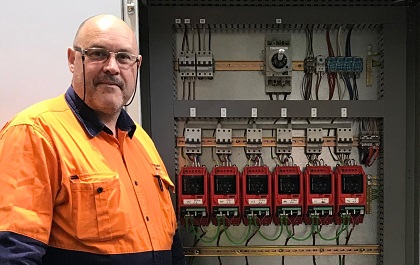
Despite enjoying his work and having worked Australia wide, he began searching for something that could really challenge him and boost his career. Brian has hankered after becoming an Electrical Engineer, but wondered how he could ever do the required study and retain his job. His employer, Foodmach Pty Ltd, to his surprise, agreed to support his ambitions.
“I’ve never heard of an employer in a small regional city giving a 52-year old employee that sort of an opportunity before; so I grabbed it with both hands, heart, head, and feet,” he said.
Brian applied for EIT’s Advanced Diploma because the learning platform is online and flexible, allowing him to continue working without the need for time off work to attend classes. EIT’s approach to learning is also very interactive; the instructors run tutorials in real-time and students interact with the instructors and each other.
“When I researched every Univeristy I could think of in Australia there was 'not one' that had this complete online platform for Electrical Engineering. I’d almost given up until at the request of my manager Gavin Alder, I researched for one more week,” he said.
“Low and behold I found the Engineering Institute of Technology online AND they offered 'exactly' what I’d been looking for.
“As much as my employer Foodmach was already prepared to support me, this also really helped to sway them all the way, without any worries about labour re-scheduling for schooling time off.”
Brian describes the course as the 'light bulb' that changed his electrical life and opened his mind. Having covered variable speed drives, induction motors, mathematics and much more, he reflected back to his trade school days and wondered why they hadn’t included some of EIT’s modules.
“The knowledge and skills alone, gained with the completion of the Advanced Diploma of Applied Electrical Engineering, has given me a considerable boost in confidence at work as a Trainee Electrical Engineer,” he added.
“I now find others, whom I consider more experienced in the electrical field, regularly seeking my advice; this has given me added confidence.”
Watching his progress through the course and noticing his growth in knowledge and skills, his employer tasked him with the electrical design of three new, small to medium sized projects.
Like most EIT students before him: holding down full time work and embarking on a new qualification, Brian found the new academic lifestyle something to get used to.
“A huge challenge for me as a 52-year old, going back to study whilst working full-time, was arranging and organising my time much better.”
The online delivery of EIT’s modules was an interesting beast to tame, but Brian eventually got the hang of it. He built up a rigorous study routine which included extensive note-taking during webinars, re-watching webinars three or four times, and attempting to ensure he had a clear understanding of all the information he was being presented with.
His resilience and determination resulted in him achieving some of the highest marks in his class.
Brian’s successes prove that you can indeed teach an old dog new tricks. He concludes:
“I’m absolutely stoked to now call myself an 'Associate Electrical Engineer'; recognised by Engineers Australia and to add these post-nominals after my name, Grad AIE Aust. This now helps me get into the next stage of my career; studying a Bachelor of Science to become an 'Electrical Engineer'.”
Now at 53-years of age, Brian appears to be as motivated as ever to achieve; part of the reason why EIT has honored him with the award. And we wish him all the very best with both his career and the next phase of his studies.
On Friday 23rd November the Perth team at the Engineering Institute of Technology was all dressed up and in celebration mode: we were delighted to be gathered to congratulate our 2018 Australian graduates.
A number of these clever people had convened, from all around Australia, and were also joined by Algate Mtemah, a student who had flown in from South Africa.
We not only celebrated the graduates themselves, their persistence and hard work, but also their incredible families and friends. It is their love and support which helps our online students through the gruelling hours of study, before or after their working days.
All of our students deserve recognition, but the Australian Graduate of the Year was ultimately awarded to Brian Lord. He graduated with an Advanced Diploma of Applied Electrical Engineering and this is what he said about it: “It was the ‘lightbulb’ that changed my electrical life and opened my mind.” He went on to ask, “…why a good portion of the study wasn’t taught to us at Electrical Trade school? It was highly relevant and would’ve opened my mind many years ago.” Despite being 53 years old he is filled with renewed confidence and looks forward to starting the BSc in Electrical Engineering.
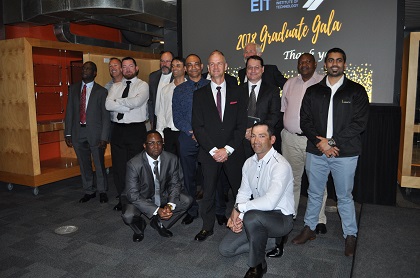
The graduates were addressed by a number of speakers. The Dean of Engineering at EIT, Dr Steve Mackay, reminded them to hone their communication skills and keep abreast of developments in their fields.
Mr Ron Manners, Chairman of the Mannwest Group and the Mannkal Economic Education Foundation, has life and business experiences which are legendary. He encouraged the students to always find perspective; he reflected on our ability to smile at our earnest endeavours when we look back.
The students also heard from Mr Cameron Norsworthy who spoke of ‘flow’- those moments when work flows efficiently and effectively, free of interfering doubts. He conceded that being well-prepared was a prerequisite.
One of our lecturers, Partha Dev, pointed out that despite their dedication and love for all things technical, engineers need to nurture their emotional intelligence - a critical asset in all our professional and personal lives.
Finally, Engineers Australia was ably represented by Mr Paul Young, President elect of the Western Australian division. His experiences in the engineering trenches proved valuable to the students.
It was a lovely evening celebrated at the newly opened EIT campus in East Perth. And it was fitting, therefore, to welcome some of our on-campus students to the event, to help us congratulate the graduates. Two of our young students were then surprised to receive awards for excellence, Victor Onoja and Binod Tamang, studying towards their Bachelor and Master degrees respectively.
Congratulations to all our EIT graduates, wherever you are based, and thank you for selecting to study through EIT. Please keep in touch with us - let us know what you are up to and how you are faring in your engineering careers.
Johannes Kapeuasha is a graduate from the Engineering Institute of Technology and at our 2018 African Graduation Gala in October he was awarded Graduate of the Year.
After completing high school in 2007 he enrolled at a college in Bulawayo, in Zimbabwe. Here he completed a certificate in computer science (database systems) and then another one in 2009 which certified him to work as a computer technician. He worked in the field for a year, but felt he needed to learn more and kick-start his career. He said:
“I decided that I wanted to be part of the robotic and artificial intelligence revolution. For me, to be part of this revolution, I immediately realized that I either had to do software engineering, electrical engineering, or mechanical engineering. I ended up choosing electrical engineering.”
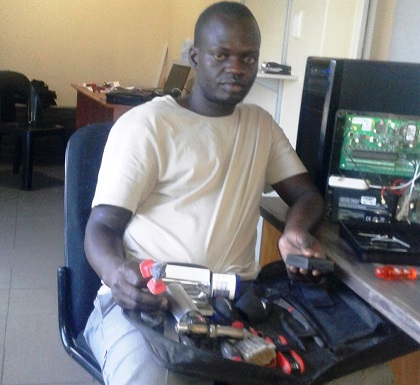
He joined the Namibia Institute of Mining and Technology (NIMT) and began studying towards the Electrical Engineering Millwright Trade. At the same time he began an internship at Namibia Dairies where he was exposed to the industrial side of the industry. In the last year of his internship in 2014, just before his trade test in 2015, he enrolled for a National Diploma in Electronic Engineering at a South African college named INTEC College.
He passed his trade test on his first try and graduated from INTEC in 2016.
Johannes is a true believer in the opportunities that education offers (and is certainly not afraid of hard work). He has since graduated from the Engineering Institute of Technology; he completed the Advanced Diploma of Applied Electrical Engineering (Electrical Systems).
While studying with EIT (which is structured to allow students to also work full time), he realised that there was something preventing him from thriving. He said:
“The job market in Namibia at the time was not favourable. It was really hard to get jobs at that time; however, I was able to make a living as a private electrical contractor, until the situation became so desperate that I was not able to get small jobs anymore.”
As a result, Johannes settled for a security guard job for a local company named Inter Africa Security Services and then later, Omega Security, which helps protect one of the busiest malls in Windhoek, in Namibia. While with this company, this year, Johannes’ luck turned around: Omega Security promoted him to the Industrial Security System Technician role. And he is enjoying his work:
“I love hands-on tasks. I love solving technical problems and having a chance to work in the field that brings me fulfilment each and every day. Technology is really growing fast, and changing everything around us and how we interact with our environment. I am truly fortunate to be part of one of the recent developments - remote arming of home security systems.”
At our Graduation Gala in South Africa, Johannes was overjoyed to be named 2018 Graduate of the Year. He is pleased to have been rewarded for his efforts in the face of overwhelming financial hardship and challenging time constraints.
“What my engineering career has taught me, if I were to sum up my career thus far, is not to be afraid and to work hard. Do not look at other professions and look down at them. Every industry needs an engineer. If you believe in something, go for it - do not let anyone say you cannot do it. You can achieve great things; all you need to do is just believe. I am living proof that anyone can achieve anything they put their minds to. Do not be afraid to dream...dream big.”
Johannes is determined and believes in himself, but these alone have not been enough to enable him to achieve all that he has. He makes it clear that without the support of those closest to him none of this would have been possible.
He wanted us to include a “special tribute to the people who made me who I am today.” His special thanks go to his mother, Mrs. Menete Kapeuasha, to his sister, Josephina Kapeuasha, to his faithful best friend, Ms. Bella Kavungo, and to his manager, Mr. Francois Van As.
Congratulations Johannes, from all of us at EIT, and our heartfelt thanks also go to your wonderful support team.
At TEQSA’s third annual conference in Melbourne, at the end of November, Dr Steve Mackay presented a paper on the Development of a Career Advisory Site; it summarised his research to date - applying machine learning techniques to millions of job adverts around the world. Caroline Patterson also attended the conference and interacted vigorously at the QA Online Learning Forum.
Despite the software still being in its infancy, Steve’s presentation (his latest project) involves the creation of a site which is able to collate and update real time job postings.
He believes it will have varied applications, but trusts it will also provide education regulators, including TEQSA and ASQA, with an objective means of measuring and assessing the value of proposed courses - courses that are currently relevant in the marketplace and courses which will enable graduates find work in their fields of study.
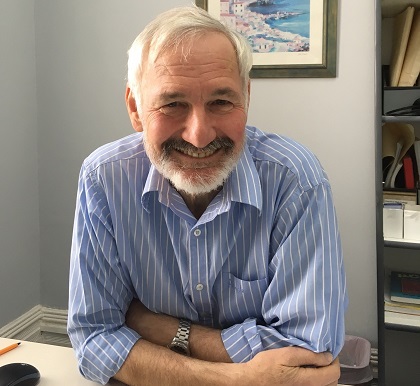
With the chatter about jobs being hollowed out, in an age when technologies are changing rapidly, Steve also anticipates the site becoming a useful guide to students, and indeed to those already working. It will provide them with an idea of the existing and emerging job opportunities wherever they live in the world.
The reputable marketing analytics company, Burning Glass, estimates that up to 85% of jobs are now posted online. It was this statistic which spurred Steve on. He realised that sophisticated ‘web spidering’ and machine learning techniques had the capacity to access up-to-date job information, for each key location in the world, and provide a real time source of data.
He has used the ubiquitous Python language, with its machine learning libraries, to classify the huge array of engineering and technology job data.
Natural language processing was then used to identify specific skill and knowledge requirements. This has been useful in summarising what a specific job requires in one city versus the same job, but with different requirements, in other cities.
Then, to ensure readability, Steve used a simple dashboard to include the job title, occupation details, proposed salary, the employer and the location. This will be released in a full online version in late December 2018.
In our modern world immediacy and convenience are expected. This career advisory site will tick both boxes for educators, regulators, would-be students, graduates, job seekers and those looking for a career change. They will have - at their fingertips - access to current information on job vacancies, across the different disciplines, worldwide.
The technological advancement in education has lagged behind other industries. Yet there are technologies available that would transform the classroom, the lecture hall, or even a person’s home, and ultimately transform learning.
The Future of Management Education Alliance wants to bring these technologies to the learners of the 21st century. The alliance is headed up by the Imperial College Business School who plan to introduce hologram technology to their MBA students.
The Imperial College Business School has an educational technology lab (Edtech Lab) that assists the school find the kinds of technologies that would better train the students at the institution.
David Lefevre, director of Imperial’s Edtech Lab said: “This gives our teaching staff a sense of presence when talking with students. Otherwise we might as well run a lecture on Zoom.”
Zoom is video conferencing software employed by some institutions to reach their students via the internet and conduct lectures virtually.
Emmanuel Métais, Edtech Labs’ dean told Financial Times:
“This initiative reflects our commitment to be at the forefront of innovation, not only to provide students with a better learning experience but to make them succeed in a fast-changing world. At Edhec, we believe that excellence and innovation are the two pillars on which our people build their own personalities and careers to make an impact on the world.”
Built by engineers, for engineers?
The hologram technology was developed by Canadian company AHRT Media.
Holographic technology can be leveraged to teach students while a lecturer is on the other side of the world. And the technology has come down in price.
It is not inconceivable to think that students may be taught by lecturers who would appear as holograms. And engineering scholars might need it most. Through simulation technology (virtual and augmented reality) engineers can be taught in virtual spaces.
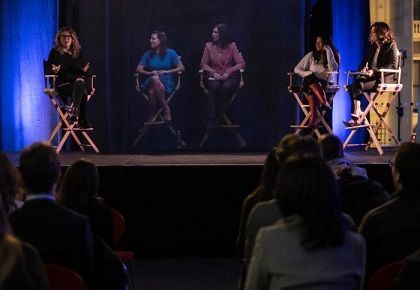
Even though the technology has not been directly targeted at engineering education, it will be in the next few years. Lefevre concludes:
“Introducing hologram technology to the classroom will break down the limitations of traditional teaching by creating an interactive experience that benefits both students and academics. Rather than replacing or reducing real-life lectures, the hologram technology will provide greater flexibility for academics by enabling them to continue teaching whilst travelling, ensuring consistency and quality for students.”
Works Cited
Moules, Jonathan. “MBA Students to Be Offered Hologram Lectures.” Financial Times, Financial Times, 1 Nov. 2018, www.ft.com/content/01749584-dcf9-11e8-8f50-cbae5495d92b.
Singleton, Laura. “Imperial College Business School to Offer Live Lectures via Hologram | Imperial News | Imperial College London.” Imperial News, 2 Nov. 2018, www.imperial.ac.uk/news/188851/imperial-college-business-school-offer-live/.
2018 marked 100 years since the end of World War I. On the eleventh day, of the eleventh month, of the eleventh hour in 1918, the Allies of World War I and Germany signed a treaty that ended the war.
World War I was a turning point in warfare. In its time, it was the most significant war with the most modern warfare equipment ever invented — Mortars, machine guns, rifles, poison gas and the surprising entrant of the flamethrower. But it wasn't just the handheld equipment and biological weapons that were new.
Even light railways were set up between the trenches upon which petrol-powered locomotives could ride and transport both soldiers and weaponry. But the British still needed something that would give them the upper hand on the Germans.

A stalemate on the Western Front, where endless trench warfare was taking place, had produced the need for a new land-based, cross-country vehicle that could breach enemy lines.
The British army then received a shipment of heavy artillery that they had never seen before.
Director of the Lord of the Rings trilogy Peter Jackson has captured some of the mysticism surrounding the arrival of the tanks in his latest documentary on World War I named ‘They Shall Not Grow Old.' Real soldiers whose stories were captured by the Imperial War Museums and sampled in the documentary relayed their stories:
"They were on the roadside covered with tarpaulin sheets. You could see nothing except a square outline."
"And then the officer said, ‘these are supposed to be hush-hush,'" another soldier recalled.
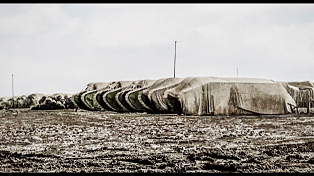
Another said, “When we asked what it was, the simple reply was: tanks. Knowing the shortage of water we had actually assumed water tanks and thought we were getting reserve supplies. It was one of the best kept secrets.”
The engineering of the tank ushered in a new era of mechanized warfare that has continued until today.
Fiction becomes fact
In 1903, H.G. Wells wrote a short story named ‘The Land Ironclads.' In the fictional story he writes about 100-foot-long armored fighting vehicles that would carry key army personnel across enemy lines. Thirteen years later, Wells’ prediction that ironclad machines impervious to machine gun fire would traverse the battlefield came true.
It was actually a young Winston Churchill - who at the time was the First Lord of the Admiralty - that had a hand in the commencement of the engineering of tanks. He set up a top-secret collective in February 1915 named the Landship Committee.
After a spot of trial and error — and a few prototypes went wrong — Sir William Ashbee Tritton (a British expert in agricultural machinery) and Major Walter Gordon Wilson (a mechanical engineer) were the designers behind the world’s first tank. It was named Little Willie, intentionally mocking German Imperial Prince Wilhelm.

The caterpillar tracks fitted on to the first iteration of the tank was good for traversing over land but got stuck when it tried to ride over any of the parapets (a protective wall or earth defense) in front of the German trenches.
The second iteration of Tritton and Wilson's invention was a more rhomboidal shape that had tracks going all the way around the hull. A mock battlefield with a trench even wider than those in the actual war was set up, and the tank was tested. It surpassed expectations. This was the prototype they sent off to the war.
David Lloyd George, who in 1916 became the secretary of state for war wrote: “At last, we have the answer to the German machine guns and wire.”
Another two prototypes were eventually released toward the end of 1917 and mid-1918 respectively. Nonetheless, the tank had woken up the militaries of the world, and in the wars to come, everyone would want one. The rest, as they say, is history.
It is estimated that nearly one million British and Empire servicemen were killed between 1914 and 1918. The total number of military and civilian deaths in the entire war was determined to be between 15 to 19 million people.
Works Cited
“How Britain Invented The Tank In The First World War.” Imperial War Museums, www.iwm.org.uk/history/how-britain-invented-the-tank-in-the-first-world-war.
“They Shall Not Grow Old.” IMDb, IMDb.com, 9 Nov. 2018, www.imdb.com/title/tt7905466/?ref_=nv_sr_1.
With the festive season just around the corner, it might be time to start planning your next vacation. While on holiday, you might be able to admire some impressive feats of civil engineering. That much is true if you're visiting the Maldives this year.
A structural engineer from Auckland is making news around the globe. His name is Michael Murphy, and he has built a hotel...underwater. Murphy is world-famous for his work on aquariums and underwater restaurants. He graduated with a Bachelor of Engineering in civil engineering at Auckland University in 1971.
The new underwater hotel villa has officially opened in the Maldives as a new addon to the Conrad Maldives Rangali Island. It’s named the Muraka. The top level is above water, and the bottom is fully submerged under the sea.

It provides the patrons willing to pay US $55,000 per night, a night's sleep 16 feet down on the Indian ocean floor.
For the hefty price, patrons get access to a 24-hour team of staff, ready to assist guests during their stay. Allegedly, there is access to a personal yacht as well.
The structure cost US $22 million to build. "It's one of the most challenging projects I've had. And super exciting at the same time," Murphy told reporters. It is now considered to be the world's first underwater hotel.
Constructing underwater
Constructing a hotel room underwater was no easy feat. The structure was prefabricated in Singapore. Three sections were assembled atop a barge that was then towed to a crane ship, which was waiting to begin construction at Rangali Island.
Steel piles were embedded into the seafloor, and after that, the two cranes atop the crane ship planted the prefabricated sections of the hotel room onto the steel foundation. The hotel was in the planning phase for 13 years. Finally getting the designs implemented on the ocean floor was challenging. Even marine biologist staff members were part of the process to ensure that the marine world below wasn't damaged by the building of the room.
Murphy told Hotel Designs:
“Site conditions are paramount. This includes tidal range, water depths, protection from storms, storm wave heights, wind loads, type of soil for driving piles, access for big crane ships etc. This dictates freeboard heights, the depth of undersea unit below the sea level, height of stairwell, piling design and everything else. The greater the volume, then the more water displaced, which means more buoyant uplift, which means more weight to hold the unit down so that it doesn’t float.”

The room just happened to be the maximum weight that the cranes could handle; it weighs in at 600 tonnes. A spiral staircase leads from the top level to the bottom level, revealing the 180 degree view of the bottom of the ocean.
Fancy sleeping with the fishes? It is now possible.
Works Cited
Undersea Villa | THE MURAKA | Conrad Maldives Rangali Island Luxury Resort, www.conradmaldives.com/stay/the-muraka/.
Kilburn, Hamish. “Designing the World's First Luxury Underwater Hotel.” Hotel Designs, Hamish Kilburn Https://Secure.gravatar.com/Avatar/2edcad40930314dca244a6a9d0589916?s=96&d=Mm&r=g, 7 Aug. 2018, hoteldesigns.net/industry-news/designing-the-worlds-first-luxury-underwater-hotel/.
Umbers, Lee. “Sleeping with the Fishes... Kiwi's $73,000 a Night Underwater Hotel.” NZ Herald, NZ Herald, 10 Nov. 2018, www.nzherald.co.nz/travel/news/article.cfm?c_id=7&objectid=12156573.
President of the United States, Donald Trump, phoned American Navy service members on Thanksgiving to discuss their aircraft catapult system.
On the phone with the commander of the USS Ronald Reagan aircraft carrier, Trump asked a few questions about the system they were using. Catapults are used to get the aircraft airborne which would otherwise be impossible with the short runways the ships have. The USS Ronald Reagan is a nuclear-powered aircraft carrier, utilizing a steam-powered aircraft catapult. The catapult diverts steam from the ship's nuclear reactor and uses it to launch the planes.
However, the U.S. Navy is in a phase of transition from steam to electromagnetic systems on some of their carriers. They are called Electromagnetic Aircraft Launch Systems (EMALS), and they are developed by an organization called General Atomics for the United States Navy.
In the last two years, the USS Gerald R. Ford was fitted with four electromagnetic catapults.
The system forgoes the steam piston and instead relies on a linear induction motor. The change seemingly helps accelerate and launch aircraft in a much smoother fashion when compared to the steam catapult systems. The steam catapults date back to World War II and require a significant level of maintenance from engineers.
The linear induction motor in the electromagnetic catapults utilizes electric currents, creating a big surge of electricity to propel the plane. But, the President thinks it isn't worth its weight in salt. He pressured the Navy to ditch the new EMALS. Speaking to Time Magazine in 2017, Trump recapped the conversation he had about the system with a member of the Ford:
"You know the catapult is quite important. So I said what is this? Sir, this is our digital catapult system. He said well, we're going to this because we wanted to keep up with modern [technology]. I said you don't use steam anymore for catapult? No sir. I said, "Ah, how is it working?" "Sir, not good. Not good. Doesn't have the power. You know the steam is just brutal. You see that sucker going and steam's going all over the place, there's planes thrown in the air."It sounded bad to me. Digital. They have digital. What is digital? And it's very complicated, you have to be Albert Einstein to figure it out. And I said–and now they want to buy more aircraft carriers. I said what system are you going to be–"Sir, we're staying with digital." I said no you're not. You going to goddamned steam, the digital costs hundreds of millions of dollars more money and it's no good."
Fast forward to the Thanksgiving 2018, Trump once again brought up the doubt he had with the electromagnetic launching systems. Speaking to an official on the USS Ronald Reagan, over the phone, Trump once again cast doubt into the electromagnetic catapults. He said:
"Steam is very reliable, and the electromagnetic — I mean, unfortunately, you have to be Albert Einstein to really work it properly."
To which the Navy service member on the other side of the phone replied:
“You sort of have to be Albert Einstein to run the nuclear power plants that we have here as well, but we’re doing that very well.”
What’s the deal?
While it seems Trump lacks the formative knowledge regarding which catapult system is best for the Navy, the electromagnetic systems have gone through some trial and error. The initial tests done on the USS Ford were a failure in 2015. It was only much later that they moderately perfected the launching system.

According to Popular Mechanics, the engineers atop the Ford were worried about the move to electromagnetic due to the first failed tests. They allegedly ‘briefly considered' going back to the steam catapults for the USS John F Kennedy and USS Enterprise which were under construction at the time.
Steam catapults, over time, are more destructive on the airframes of the aircraft it launches. EMALS would, therefore, be a better investment. But, the Navy Times reported in January 2018 that EMALS ‘may not be ready for the fight.'
The Director, Operational Test and Evaluation report states:
“Poor or unknown reliability of the newly designed catapults, arresting gear, weapons elevators, and radar, which are all critical for flight operations, could affect the ability of the carrier to generate sorties, making the ship more vulnerable to attack, or create limitations during routine operations. Based on current reliability estimates, CVN78 is unlikely to be able to conduct the type of high-intensity flight operations expected during wartime.”
Nonetheless, some of the lieutenants are reporting that the steam catapults make for a very violent takeoff experience, a problem that the EMALS don't seem to have. The EMALS could reduce the amount of bouncing the plane does before it gets launched off of the runway, which would be an advantage. However, the urge to rapidly digitize the ships has some in the Navy, and the US President himself saying, "not so fast."
Works Cited
Miller, Zeke J. “Donald Trump: TIME Interview on Being President.” Time, Time, 11 May 2017, time.com/4775040/donald-trump-time-interview-being-president/.
Mizokami, Kyle. “Donald Trump's Problem With the Navy's Electromagnetic Airplane Catapult, Explained.” Popular Mechanics, Popular Mechanics, 15 Feb. 2018, www.popularmechanics.com/military/weapons/a26478/donald-trump-emals-steam-catapult-aircraft-carrier/.
Ziezulewicz, Geoff. “Report: EMALS Might Not Be Ready for the Fight.” Navy Times, Navy Times, 16 Feb. 2018, www.navytimes.com/news/your-navy/2018/02/16/report-emals-might-not-be-ready-for-the-fight/.
It's the year 2021. You are on a cruise ship, soaking in the sun, inhaling crystal clean air, and drinking a cocktail. While you're on this vacation, it never occurs to you that the very ship you are on is being powered by rotten fish.
Yep. The Norwegian cruise liner group Hurtigruten is planning to power their ships using biogas, liquified natural gas (LNG) and solar-powered battery packs. Biogas is made with organic material like dead plants and animal waste. The company will speed up the decomposition of organic waste and capture the methane it produces.
The group intends to have these ‘fuels’ in place and ready to power their fleet by 2021.

Hurtigruten CEO Daniel Skjeldam told the Telegraph:
“What others see as a problem, we see as a resource and a solution. By introducing biogas as fuel for cruise ships, Hurtigruten will be the first cruise company to power ships with fossil-free fuel. While competitors are running on cheap, polluting heavy fuel oil, our ships will literally be powered by nature. Biogas is the greenest fuel in shipping, and will be a huge advantage for the environment. We would love other cruise companies to follow.”
The company says that it will be utilizing the cutaways from fisheries and other organic waste will soon be used in the ships. It is quite clear that the electrical engineer on the cruise liners, is going to be seeing some of the world’s first alternative powering methods for ships.
The move will cost the company US $826 million over the next three years, to fit six of the 17 ships in the fleet with the new technology. The company is buying three new vessels that will be run only on clean electricity technology. But they will have diesel engines as a backup.
Skjeldam told media that his ship's crew members have seen how ‘glaciers retreat' due to climate change, possibly caused by emissions. He adds that the crew members say they also observe too much plastic on beaches where the ships land. Consequently, Hurtigruten confirmed that they will do away with single-use plastics.
Powering ships while docked
It is not the first time clean energies are being implemented in the cruise liner business. Siemens has developed a technology for when ships are docked at the harbor to ensure they do not create unnecessary air pollution.
Most cruise liners still utilize diesel generators that power their vessels. At a harbor, however, the air quality is a concern. Therefore, running a ship for a prolonged time while docked increases the chances for emissions to degrade the air quality at the harbor.
To combat this problem, Siemens developed the first European onshore power supply for cruise ships back in 2015. The system allows the ships to turn off their diesel generators while in the harbor. They have dubbed it the SIHARBOR shore connection system.
Berthed ships of all kinds can benefit from this setup due to how flexible and straightforward it is. A simple cable management system it all it takes to connect the ship to an onshore source of power. Siemens has their own patented robot arm that feeds the cable system to the boat, specially designed for the tidal range of the ocean.
The trend rising of powering cruise ships offshore and onshore with clean power is encouraging to observe. Ninety percent of the world's goods are transported via ships — making them cleaner will be good in a world craving fuels that emit fewer carbon emissions.
Works Cited
Featherstone, Emma. “Hurtigruten Cruise Ship to Be Powered by Rotten Fish in World First.” The Telegraph, Telegraph Media Group, 19 Nov. 2018, www.telegraph.co.uk/travel/cruises/news/rotten-fish-to-be-partly-used-to-power-hurtigruten-cruise-ships/.
“Forum for Science, Industry and Business.” How Are Cells Held Together?, www.innovations-report.com/html/reports/energy-engineering/siemens-builds-the-first-european-onshore-power-supply-for-cruise-ships.html.
For 15 years, the city of Gweru in central Zimbabwe has been increasingly dry, with water failing to flow into one of their reservoirs. However new water infrastructure would cost the council US $10 million. Since Zimbabwe is enduring extraordinarily tough economic times, an expense of this magnitude was daunting.
As is so often the case, a group of engineers managed to save the day! With little in their public coffers, the Zimbabwean government enlisted the help of the German Development Cooperation-GIZ-Ausaid. GIZ-Ausaid’s head of urban water and sanitation, Mr Stephen Lidsber told the Herald newspaper:

“We asked them what was wrong with the old infrastructure. We decided to fly in a team of German engineers to look at the problem. They spent a good two months looking at ways of getting the water into the city’s reservoir. They discovered it was just a single valve that was malfunctioning. So they opened the valve and they are now able to pump water into the Kopje reservoir tanks.”
Instead of the anticipated $10 million, the German engineers cost the Zimbabwean city US $60,000.
The German Ambassador to Zimbabwe, Thorsten Hutter, praised the city’s frugal approach to the problem. He said:
“Maintenance is always cheaper than buying new equipment. As a local authority, it is important you invest in maintenance. This partnership shows good cooperation based on mutual respect and I hope it will last for a long time.”
Can we fix it? Yes, we can
A culture of consumerism has, unfortunately, become the norm; even fashionable. It has resulted in many industries intentionally engineering products that break more quickly than in the past. This approach has turned us into a throw-away society — it encourages us to replace products rather than consider alternatives.
However, the old culture of repair is at last re-emerging and will, in time, replace our tendency to discard engineered products.
It is a significant shift, particularly for those nations having to eke out scarce resources.
And then there is the issue of landfill.
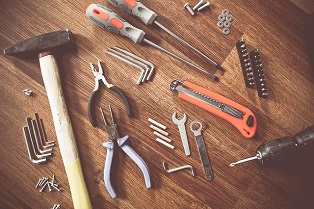
According to the North London Waste Authority (NWLA), in the UK 22 million pieces of furniture, 11,000 bicycles, and over 28 million toys are thrown away every year when in reality they could be repaired. The NWLA’s Clyde Loakes told Sky News:
“We’ve got ourselves into a bit of a rut and it’s not just a London thing, it’s not just a UK thing, it’s a global thing. We buy things for a certain period of time and when it breaks, because we’ve lost the skills to fix things, we just throw those items away and it’s just easier and more convenient to just go and buy a replacement.”
Several groups or clubs are starting up in Europe (and indeed elsewhere); they encourage meetups to assist with repairing technology. Some groups like ‘The Restart Project’ host parties and promote volunteerism in the repairing industry. Their website indexes repair parties across England. It says:
“Come to one of our free community repair events, where our volunteer fixers will help you learn how to repair your broken or slow devices - and tackle the growing mountain of e-waste.”
The Culture of Repair Organization’s website targets a wide audience; with some of their educational resources for those still at school. It is likely that curricula encouraging a culture of repair will become commonplace in the next few years.
One startup, the Fixit Clinic, is training the designers and engineers of tomorrow to manufacture longer-life products. The clinics hope to influence the way designers and engineers design and create products later on in their careers.
The culture of repair supports the environmentalist: where the world of manufacturing becomes more sustainable and is in sync with other, but related environmental principles: reuse, reduce and recycle.
Works Cited
“Educator Resources.” Culture of Repair, www.cultureofrepair.org/educator-resources/.
Herald. “The Herald.” The Herald, The Herald, 16 Nov. 2018, www.herald.co.zw/.
Vittozzi, Katerina, and Sky News. “We Throw Away Millions of Items That Could Be Repaired.” Sky News, Sky News, 4 Nov. 2018, news.sky.com/story/we-throw-away-millions-of-items-that-could-be-repaired-11544441.
Can a construction crew finish building a house in a week?
What about in 24 hours?
Winsun (also known as Yingchuang Building Technique) is a Chinese construction company that can 3D print a house in 24 hours. The company is at the forefront of 3D printing architecture. Founded in 2003, Winsun currently holds 151 national patents pertaining to their construction materials.
The company has also been recognized as an essential contributor to the ‘one belt one road' policy. The Chinese Government's infrastructural policy aims to connect Asia, Africa, and Europe. It's inspiring sustainability in construction, energy, and transportation.
The 3D printing technique employed by Winsun could go global, considering the Belt and Road Initiative's influence is expected to reach up to 70 countries.
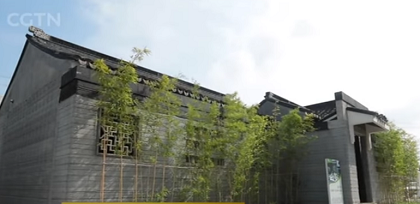
In Jiangsu Province, the company has been printing structures that embody Chinese history and culture, while providing a look into the future of creating Chinese homes, business offices and more.
The process is relatively new. It utilizes a 3D printing cement ink that combines cement, sand, and fiber together with an additive resin that allows layer by layer printing. What the company essentially created was ‘Special Glass Fiber Reinforced Cement.'
Senior Engineer at the Shanghai Research Institute of Building Sciences, Ya Beihong, told CGTN that the 3D printed material has better anti-crack properties than traditional cement. This is due to the added fibers that are pushed through the printing nozzle.
As a result, the houses should be durable, and assuage the many critics who have wondered how sturdy they would be.
Winsun first made news headlines in 2013 when they claimed to have printed 10 houses in 24 hours. Then, in 2015 they printed a six-story apartment building, which only cost US $160,000 to produce.
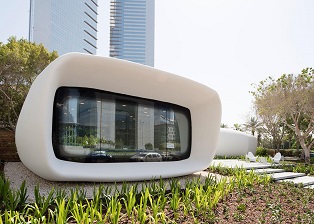
Ma Yihe, the CEO of Winsun said, "industrial waste from demolished buildings is damaging our environment, but with 3D-printing, we are able to recycle construction waste and turn it into new building materials."
Yihe says that developer costs are cut by 50 percent when buildings are 3D printed. Moreover, with robots taking care of every part of the house's fabrication, a construction crew is not technically necessary — and will be even less essential as the technology develops.
The company says they will be printing bus stations, public toilets, and affordable houses in China soon.
Winsun was the construction company behind the first 3D printed office that was printed in Dubai. The UAE is looking to rely on 3D printing buildings as a part of their 2030 mandate to have most of its construction works done via 3D printing.
The 3D printing building technique could also have positive spin-offs for the globe. If housing is a fundamental right for all humans, the printing method could create housing at a much more affordable rate for those in the world needing shelter. Every level of the construction process is digitized and ultimately futuristic.
Works Cited
About Winsun-Yingchuang Building Technique (Shanghai)Co.Ltd. (WinSun), www.winsun3d.com/En/About/.
Dubai Future Foundation. “THE OFFICE OF THE FUTURE.” 3D PRINTED OFFICE - DUBAI FUTURE FOUNDATION, www.officeofthefuture.ae/.
“Living in the Future: 3D Printing Shaping the Construction Sites of Tomorrow.” YouTube, 2 Nov. 2018, youtu.be/XEVkosH_-gQ.
Friday 30 November is Systems Engineer Day!
A systems engineer's job is to create and manage complex systems. They ensure that the system has a good life cycle and that all systems are running efficiently.
This celebration debuted in 2012, lauding the engineers who, through design and implementation of digital solutions, make a difference in the many workplaces globally. On the day, everyone is encouraged to high five their systems engineer and show their appreciation.
Systems engineers are becoming increasingly valuable to companies as the Fourth Industrial Revolution brings about complex networks to facilitate the Internet of Things. These system engineers are vital and essentially — at least in the interconnected technological industry— make the world go round.

Systems engineers have to work tirelessly to understand user experience. They need to tailor their systems to what they think other people will enjoy and consider efficient.
Dice Insights, an institution which provides advice for tech professionals, reports that systems engineers with an extensive understanding of Linux systems specifically, could be looking at a bigger salary per month.
How to become a systems engineer
According to Dice Insights, the best path to becoming a systems engineer starts with a degree in computer science, information systems, or engineering. They write:
“As systems engineers gain experience, they’ll learn the tools and techniques necessary to manage systems at scale--for example, a senior systems engineer (i.e., systems engineer III) will not only need experience in designing and implementing the overall architecture of a software system, but must have tactical knowledge of virtualization, containers, systems design tools and languages, and analytics.”
Systems engineers need to be fully aware of what networking technologies are available. They should also anticipate the release of new ones that they can implement.
System engineers can go by many names, according to SystemsEngineerDay.com. They can be called systems engineers, infrastructure engineers, system integrators, architects, system analysts, and more.
It’s therefore clear that systems engineer can be present across most of the disciplines of engineering. With engineering becoming more and more interdisciplinary, education institutions are creating new qualifications to formalize the domain expertise moniker of ‘systems engineer.' Boston University has a minor qualification, MEng, MS, and Ph.D. in Systems Engineering.
They say that their graduates can work in a plethora of industries that include but are not limited to:
- Developing computer simulation packages for software providers
- Building and evaluating models for communication, computer and sensor networks
- Developing effective air traffic management systems
- Analyzing the feasibility of relying on teams of autonomous vehicles for military and civilian applications
- Developing, enhancing and maintaining quantitative stock selection models that are used to pick high-performing stocks for clients
- Developing and supporting software that optimizes a company’s global supply chain operations and provides multiple-year production plans based on various supply, demand and capacity scenarios.
- Inventing new scheduling and production control algorithms for manufacturing enterprises.
- Developing a pairing optimizer and crew controller, to provide crew pairing and rostering for more than 30 airline companies all over the world.
- Designing innovative algorithms and software to direct user traffic across the internet, optimizing the end-user experience.
The Engineering Institute of Technology’s Dean of Engineering, Steve Mackay, says that adding systems engineering into the career mix is a wise decision. Systems engineering, in his opinion, represents the function of teaching the old engineering ‘dog’ new tricks. He writes:
“Systems engineering would appear to be mainly in the aerospace and military sphere but it is across all fields of engineering ranging from car manufacturing, building plants & infrastructure, oil and gas, mining and transport and in many newer areas. A great example of a growing field of systems engineering is the smart grid - dynamic, complex with many different disciplines involved in its creation coupled with a high degree of uncertainty and a great opportunity to optimize. Or smart self-driving cars - the number of different disciplines here are mind boggling.”
Consequently, if you know someone working towards becoming a systems engineer, who can grapple with all of the technological development that the convergence of engineering disciplines has produced, celebrate them this Systems Engineer Day.
Works Cited
KolakowskiNovember, Nick. “Systems Engineer Salary Rises Even Higher with Linux Experience.” Dice Insights, Dice, 16 Nov. 2018, insights.dice.com/2018/11/13/systems-engineer-salary-rises-even-higher-with-linux-experience/.
“What Is Systems Engineering?” Family and Medical Leave Act (FMLA) | Human Resources, www.bu.edu/eng/departments/se/prospective-students/what-is-systems-engineering/.
“What Is Systems Engineering?” Family and Medical Leave Act (FMLA) | Human Resources, www.bu.edu/eng/departments/se/prospective-students/what-is-systems-engineering/.
“Systemsengineerday.com.” Systemsengineerday.com, www.systemsengineerday.com/.
Mthulisi Mlalazi Thenga is a 28-year old, qualified Control & Instrumentation technician. He mainly specializes in system integration & automation. In 2005, Mthulisi graduated from high school in Zimbabwe, but decided to migrate to Botswana. He would visit Kgalagadi Breweries in the region and be fascinated by the automated processes at the plant. He ended up spending some time in the technical departments there assisting with the electrical, control and instrumentation technologies.
As a child Mthulisi found he had a profound love for machines. He was also keen to discover how electricity was generated. Clearly he was already actively – but perhaps even unconsciously - trying to find which niche of engineering and technology he would fit into as an adult.
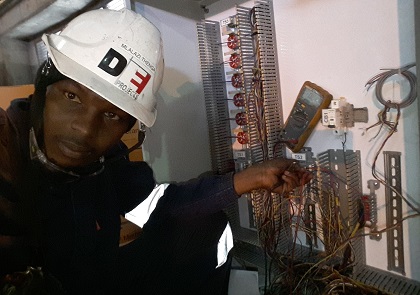
“Finally I realized my loyalty was in Control Engineering. I went back to Zimbabwe to start my tertiary education at Bulawayo Polytechnic College. I worked hard and excelled,” Mthulisi said.
As a result he qualified as an electrical technician and a registered qualified specialist in the following disciplines:
- Industrial communication.
- Networking and high speed nonmetallic communications.
- Control systems engineering.
Through EIT, he completed further studies and graduated with an Advanced Diploma in Electrical & Instrumentation (E&I) Engineering of Mining and an Advanced Diploma of Applied Electrical Engineering.
During his apprenticeship Mthulisi’s work included the maintenance of heavy industrial equipment; since then he has moved up into system integration and automation.
Incredibly, he has had a hand in either modifying or commissioning projects at thermal power stations in South Africa, at the Unilever plant in Kenya, at the Dundee Precious Metals smelter in Namibia, at the First Quantum Minerals Kalumbila mine in Zambia, and more.
And he says of his work, “I automate and breathe life into chemical plants, water treatment plants, manufacturing firms and mineral processing plants,” he said. “I am passionate about control systems and I have been on teams that have worked hard to make the world a better place.”
The online platform that EIT employs must be scrutinised and who better to do this than the students using it.
Mthulisi’s assessment is insightful; he does not hesitate to outline the challenges faced by someone working long, hard shifts and studying online at the same time. He warns people off, “if you have problems with motivation, procrastination and need lots of individual attention from an instructor.”
On the other hand he states, “Online training is the future”. He believes it teaches students to become “survivors”, “…it taught me how to plan and how to be responsible”.
He loved the flexibility and savings – with a computer and internet he was able to study anywhere and, because he did not have to commute to and from a campus, he saved time and money.
He was kind enough to describe the EIT online platform as “outstanding” because of the uniqueness of its remote labs, student access to library resources and the live streaming of the webinars twice daily (which are also recorded for revision purposes).
Mthulisi did, however, point out something that EIT is poignantly aware of: “Some content isn’t ever offered in an online format. For example, you can watch a hundred videos on welding, but until you have that welder in your hand, you’re never going to master your technique”.
In closing, the following advice from this proactive, driven and passionate young man is also worth sharing: Keep in touch! Listen to business and engineering leaders on LinkedIn and on other social media forums! And actively contribute! He believes this helps him “grow and transform day by day”.
The Engineering Institute of Technology was delighted to welcome representatives from the Universiti Putra Malaysia, on the 29th October 2018.
The delegation was made up of a wonderfully enthusiastic group of ten students, the university’s principal, Dr B.T. Hang Tuah Baharudin, and the students’ chaperone.
For an education provider dedicated to engineering we are conscious of the need to lure females to this largely male-dominated industry. It was very exciting, therefore, to meet these ten visiting students, all of whom were women!
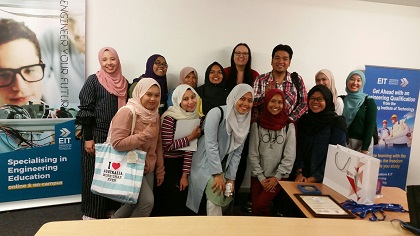
Over a morning tea the students were welcomed to EIT by the Compliance and Accreditation Manager, Ms Caroline Patterson. She gave them an overview of the college and proudly encouraged them to visit Perth’s beautiful sites while here.
The visitors then gave short presentations. Each student outlined her study focus and career dreams, post-graduation, in engineering.
Thereafter Mr Paul Celenza, the College Manager, provided the students with an insight into EIT’s unique approach to engineering education. He explained how engineering experts from around the world reach and teach EIT students in 146 countries, using a live online approach.
The visitors were fascinated when Paul recalled the story of an EIT student (and scientist), who was able to continue his studies while working in Antarctica!
Mr James Theodosiadis (Engineer, Lecturer, Laboratory Coordinator) gave the visitors a taste of the remote labs (connected to real equipment), the virtual labs and the simulations that EIT students access for their practical applications. The visiting students enjoyed that they shared, with James, the same engineering vernacular.
Dr Milind Siddpura, Learning Support Officer and Lecturer, then welcomed the students onto the EIT campus. He outlined the blended form of learning used for our on-campus students.
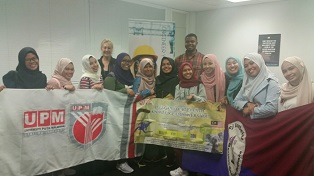
Back row: Ms Miriam Munitz, (in charge of EIT Student Services)
and Mr Victor Onoja, EIT Master student and Academic Assistant
At the end of the day the Malaysian students were put to work! Mr Victor Onoja, a Master student at EIT and Academic Assistant, had them participate in a maths evaluation quiz. They were excited by the opportunity and their confidence (as they illustrated their solutions on the board) was well-founded; they all did exceptionally well.
Our visitors were extremely appreciative of EIT’s hospitality and demonstrated this with a range of lovely gifts.
All of us here at the Engineering Institute of Technology wish our Malaysian visiting students everything of the best in their studies. We know that they will indeed make impressive engineers in time, ably contributing to their Malaysian communities.
Future generations will judge us for not taking the necessary precautions to offset the effects of climate change on our world. The blame will inevitably involve our reticence to cut down on fossil fuels. In reality, however, the task is massive and will rely on science, technology, engineering and government all committing to solving the problem.
Mark Lynas, a British journalist and environmentalist, has been issuing warnings since 2007. He explains what will happen to the world if the earth continues to warm, Six Degrees: Our Future on a Hotter Planet.
In one chapter he writes about the Palmer Drought Severity Index — a computerized forecast run by the Hadley Centre at Britain's Meteorological Office. This computer model calculates the likelihood of drought in the century to come. In 2007 he wrote the following:
"The results were deeply troubling. The incidence of moderate drought doubled by 2100 — but worst of all, the figure for extreme drought (currently 3 percent of the planet's land surface) rose to 30 percent. In essence, a third of the land surface of the globe would be largely devoid of fresh water and therefore no longer habitable to humans."

This prediction is based on global warming of higher than one degree. And according to a recent study published in the Nature Journal, the Panel on Climate Change (IPCC) believes that by 2100 the temperature will rise by 2 to 4.9 degrees Celsius.
Adrian Raftery, the author of the study, said:
"The likely range of global temperature increase is 2.0-4.9 (degrees Celsius) and our median forecast is 3.2 Celsius. Our model is based on data which already show the effect of existing emission mitigation policies. Achieving the goal of less than 1.5 C warming will require carbon intensity to decline much faster than in the recent past."
Importance of education and teamwork
Experts believe that if engineering disciplines come together to figure out a path forward, the looming water and energy crises can be solved. However, with universities still catering to individual subjects, a shake-up in education needs to occur.
This, according to a study entitled, Adapting to Engineering Education Vision 2020, published by the Multidisciplinary Digital Publishing Institute.
The authors say that in many countries universities have pursued curricula that teach students ‘soft skills' instead of the ‘professional skills' required for engineers. And yet the world needs competent engineers if they are to solve existing and growing crises.
Technological advancement is making it easier for humans to solve the world's most pressing issues. With the right education people will be well placed to manipulate these new technologies to create positive outcomes.
The authors of the report write:
“It is not possible without putting the emerging bio, nano, and info technologies together in power and energy research laboratories under interdisciplinary and trans-disciplinary approaches. Electrical engineers badly need the supportive hand of energy scientists and technologies to overcome global power, energy, food, and water crises. Engineers and scientists often find it difficult to tolerate each other and usually end up with duplicate resources without presentable output which requires motivation to develop teamwork spirit to succeed.”
The authors believe students who have an affinity for energy in chemistry subjects will eventually work in new fuel cells or solar cells. This would provide a great opportunity for engineers and scientists to work together. They say that scientists and engineers are stuck in ‘discipline defense politics' and are squandering this chance to collaborate.
Interdisciplinary curricula within degree programs are helping to equip students to tackle current world problems. The authors of the study point out that an updated engineering curriculum might see the following modules present in the coursework: renewable energy, molecular electronics, polymer solar cells, solar paints, and photochemistry.
The authors conclude:
“Future energy supply to society is a big challenge that individual disciplines cannot harness alone without developing a spirit of interdisciplinary research and development. Keeping in view world energy sources and global power needs, we must readjust our energy wasting attitudes and prepare our generation to cope with future power and energy crisis.”
Works Cited
Raftery, Adrian E., et al. “Less than 2 °C Warming by 2100 Unlikely.” Nature News, Nature Publishing Group, 31 July 2017, www.nature.com/articles/nclimate3352.
“Six Degrees by Mark Lynas.” Goodreads, Goodreads, www.goodreads.com/book/show/227477.Six_Degrees.
Yasmin, Musarat, et al. “Adapting to Engineering Education Vision 2020.” Proceedings, vol. 2, no. 21, 2018, p. 1365., doi:10.3390/proceedings2211365.
By all accounts engineering remains a male-dominated industry.
In 2015, the U.S. Department of Commerce reported that women fill 47 percent of all jobs, while men take up the other 53 percent.
However, according to more recent figures from the National Science Board, women only filled 24 percent of STEM jobs in 2018. And the industry in which women are least represented? Engineering.
TechCrunch writer Dr. Ioannis Miaoulis, president and director of the Museum of Science in Boston, says the numbers are ‘startling.' He writes:
“At a young age, girls internalize long-lasting stereotypes that tell them that boys are better at engineering and computer science, and that girls simply aren’t engineers. And during these formative years, they never have an opportunity to imagine themselves as engineers.”
Dr. Jordan B Peterson, a professor of psychology at the University of Toronto, explains why that might be:
“Women are tilted towards empathizing and males are tilted towards systematizing. That seems to fall into alignment with other observations suggesting that, the biggest gender difference between adult humans is interest preference. Women are much more likely to express interest in occupations that involve a lot of social contact, whereas men are more likely to manifest interest in occupations that have to do with things.”
Peterson points out that even in the Scandinavian countries — considered the most gender equal societies in the world — the most striking gender differences exist, based on occupation. He reports that the ratio of male nurses to female nurses is 1:20, and the ratio of female engineers to male engineers is also 1:20.
Breaking boundaries
Dr. Ioannis Miaoulis notes that even with the advocacy groups and the many institutions prepared for increasing numbers of female engineers, the results are disappointing.
The Engineering Institute of Technology has seen more women apply to the institution as the boundaries of entry for women lowers in the education sector. A 24-year old female Advanced Diploma of Civil and Structural Engineering graduate from EIT, Oyama Khanyisile Vundla, is a driven young woman ready to take on the Engineering world. She says:
“Media plays a huge role in people’s perceptions of how men are equipped for engineering and women are not. Even the movies we watch display men as engineers, people end up believing that women can’t survive in these industries. I would definitely advise young women to pursue this industry and cast away all the negative spin that says we can’t survive in this industry.”
What else can the world collectively do to inspire more females to join the Engineering workforce?
Apparently the answer is to play video games!

A study published in the journal Computers in Human Behavior reports that girls who play a plethora of video games between the ages 13 and 14 are more prone to investigating STEM job opportunities in their future.
Through the demographics of the women polled in the study, it was clear that a majority of the women who identified themselves as gamers were studying STEM subjects at degree level.
The study conducted by Director of Ph.D. in Higher Education at the University of Surrey,
Anesa Hoesin said:
“Our research shows that those who study STEM subjects at degree level are more likely to be gamers, so we need to encourage the girl gamers of today to become the engineering and physics students and pioneers of tomorrow.”
Hosein is trying to pressure educators to introduce gaming to girls at a young age so that they become familiar with interacting with technology at a high level.
We could also use platforms such as YouTube to get girls interested in a digital future where an equal number of men and women are engineers. A YouTuber named GoldieBlox features a young female engineer showing off her skills to a wide audience of 561,345 subscribers.
Goldieblox is a digital media, publishing and consumer products company that is helping inspire girls in STEM fields. They target their content towards young girls, in the hope of encouraging them to pursue STEM opportunities in the future.
Currently, only 11 percent of engineering faculty in the US is women. The key to improving this statistic seems to revolve around getting girls involved in engineering at a younger age. New strategies must be tested so humanity can benefit from the contribution women could bring to the engineering industry.
Works Cited
“'Geek Girl' Gamers Are More Likely to Study Science and Technology Degrees.” University of Surrey, www.surrey.ac.uk/news/geek-girl-gamers-are-more-likely-study-science-and-technology-degrees.
Miaoulis, Ioannis. “We're Addressing Gender Disparity in Engineering Way Too Late.” TechCrunch, TechCrunch, 26 Oct. 2018, techcrunch.com/2018/10/26/were-addressing-gender-disparity-in-engineering-way-too-late/.
Ramble. “Jordan B Peterson: Why so Many Male Engineers and Female Nurses?” YouTube, YouTube, 7 Aug. 2017, www.youtube.com/watch?v=d7uZOAzVRgU.
The EIT remote and virtual lab platform
The EIT lab hosting platform, Electromeet, connects students with lab computers in real time using TeamViewer software. Once connected, students will have access to a wide range of engineering software and connected hardware, which will be used in practical assessments throughout their course. Utilizing the Electromeet scheduling system, students are able to pre-book exclusive access to the required labs for when they are needed. The labs consist of:
- Virtual labs; computers hosting software for a multitude of engineering applications, including: modelling and analysis, science education, programming, power network design, construct models, design and drafting, project management, industrial process control, and virtual plant field operations.
- Remote labs; computers connected to physical equipment and sensors equivalent to the traditional university engineering lab. These practicals are interactive, controllable, variable, and viewable over webcams in real-time, with examples including; data communication and protocols, scientific instrumentation, physical experimentation, the control and observation of circuits, systems and machinery, and robotic automation.
Electromeet online lab hosting provides EIT students with on-demand access to professional engineering software and lab equipment, from anywhere in the world, subject to an internet connection. The booking and access page stipulates which software and physical equipment is available on each lab. Access is via the website: https://lab.electromeet.com/Home
EIT remote and virtual labs are hosted primarily in Perth, Australia, but additional labs are located in Johannesburg, London and Singapore. If a lab is offered in more than one of these locations, for an improved experience, EIT strongly suggests selecting the lab in the location which has the lowest latency for the student.
Demonstrable industrial experience
Embedded within the EIT Bachelor of Science and Master of Engineering curriculums is the requirement to complete 240 hours of engineering discipline-specific industrial work experience, with one or more companies, under the supervision of a professional engineer. Students are required to attend a site visit prior to independently undertaking industrial experience.
The primary objective of this requirement is to ensure that students have had the opportunity to learn about real situations in engineering practice; by working both independently, and in groups, and contributing to professional work related to their engineering specialisation in a meaningful way. Work experience may be achieved in numerous ways ranging from roles as junior members of teams, to tasks that form part of discrete engineering projects.
Through participation, observation, and engagement, students will: enhance their understanding of how organisations function, put engineering theory and concepts learned in the classroom into practice, develop their professional competencies, gain perspective on the realities of practice, and develop their judgement, innovation and problem solving skills.
In addition to understanding the company structure and activities, the student will be exposed to organisational policy and culture, interact with employees and other engineering disciplines, familiarise themselves with organisational communication procedures, and obtain insight and practical aptitude regarding projects; from the planning phase to completion.
For school leavers, the concept of networking and applying for industrial experience can be very daunting. EIT provides assistance to on-campus students in communication and presentation skills, contacting companies, arranging a site visit, and accessing a network of local engineering companies in order to meet the course requirements and pursue vacation work opportunities.
Students who already possess significant industrial experience in their engineering discipline of study may apply for recognition of prior learning to meet this requirement.
EIT also readily engages with distinguished industry guest speakers who are able to share their experiences and expertise.
Hands-on with engineering equipment and experimentation
Demonstrable practical hands-on work is a requirement of many professional engineering societies and accreditation agencies around the work and is an essential component of the EIT Bachelor of Science and Master of Engineering programs.
Whilst these programs include contextualised remote and virtual labs; equivalent to, or considerably more comprehensive than a traditional classroom-based program; it is essential to verify that students are competent in hands-on work skills, including; practical tool usage, workplace safety, physical measurement, experimentation, construction, assembly and working in an engineering team, within the context of their discipline. The workshops commence with a first aid course and each session requires students to undertake a job safety analysis. In total, there are four workshops for Bachelor’s students and five for Master’s students.
The Hands-on workshops are also conducted to provide the supplementary exposure to the course units. For example, the Hands-on Workshops cover laboratory experiments related to Physics as well as Chemistry; mechanical workshops apply theoretical concepts related to mechanisms, machines and processes; civil workshops relate to materials, surveying and construction; industrial automation workshops relate to instrumentation and controllers; and electrical workshops relate to circuits, switchgear, transformers and electrical motors. The latter workshops foster high-level technologist drafting and design skills and the Master’s workshop has engineering project teams working on a discipline-related comprehensive industrial case study.
On-campus and online students will elect to attend one of the annual workshop deliveries, at an EIT campus, but no sooner than having completed three semesters of full-time equivalent study to ensure sufficient prerequisite knowledge and skill. Subject to demand, workshops are run over four weeks in Perth and Johannesburg, commencing in January and November each year, with a fifth week for Master’s students. On-campus students may also choose to complete the initial workshops over the course of a semester.
Students who already possess significant industrial experience in their engineering discipline of study may apply for recognition of prior learning to meet this requirement. Master’s students who possess an accord-recognised undergraduate qualification are exempt from the first four workshops.
At the foot of the pyramids of Giza, a new museum is taking shape.
Five thousand Egyptian civil engineers are hard at work to complete the Grand Egyptian Museum. Construction began 16 years ago, and the doors are expected finally to open in early 2019.
One of the firms attached to the build is Buro Happold Engineering. They say the museum will be a construction where ‘mathematical precision meets elegant vision.'
The initial call for proposals for the museum was in 2002. The winning designers were Heneghan Peng from Dublin, Ireland. They worked alongside Arup, an independent firm of designers, planners, and engineers. The exhibition design was completed by Metaphor and Cultural Innovations Ltd.
It is expected to assume a 50 hectare stretch of land and will go down as one of the most audacious museum builds in world history. Director General of the museum, Tarek Tawfik told CNN:
“This will be the museum of the 21st century. All means of modern technology have been taken into consideration in order to make this an unforgettable experience for the visitor, but at the same time provide the best possible environment for the artifacts.”
The museum's construction is expected to cost US $1 billion. Inside it are the country's most marvelous relics and artifacts of the past. The Colossus of Ramses II, weighing in at 121 tonnes, (already transported across Egypt) is to be moved to the Grand Egyptian Museum. He will be standing tall above the visitors at the museum’s entrance.
A Horus God statue has also been transferred from Al-Masalah Garden in Zamalek to the Grand Egyptian Museum.

The building has been constructed to resemble a chamfered triangle — a homage to the pyramids. Built on a sand hill, engineers had their work cut out for them. Tawfik said:
“This made it a bit more difficult to prepare the location, but it had the big plus point that there was no fear to stumble over antiquities here because the ancient Egyptians didn’t build any temples or carve any tombs into sand.”
Another feat of civil engineering will be an 800 meter long, 40 meter tall translucent stone wall, erected just in front of the museum. When tourists approach from the Cairo side, the translucent stone will produce a natural, inviting entrance to the museum. An 800-seat auditorium is also to be opened inside the museum.
The museum is downwind from the Giza pyramids and perfectly adjacent to the Giza pyramids, just two kilometers away. Another phase of the construction includes building a Conservation and Energy Center (CEC) that will house a conservation center, conservation plant, and a fire station.
Conservation
While being an impressive feat of civil engineering, the museum will also be an enigma of conservation.
The museum will also include King Tut-Ankh-Amun's Treasure — the only complete set of royal belongings in Egyptian antiquities collections.
Two-thousand-and-six of King Tut's 5,300 possessions will be shown off in the Grand Egyptian Museum. Conservationists are in the process of polishing the artifacts with specialized techniques, ensuring not to cause any damage.
One of King Tut's sandals was said to be beyond restoring, yet it has been done and is now present in the collection. Consequently, the museum's construction has also spurred one of the most significant restoration projects in the world.
Other attractions include artifacts from Queen Hetepheres I’s tomb; these antiquities were discovered in 1925.
The museum's visitors will have the chance to look at artifacts that date back at least 3,500 years. The Egyptian government is hoping that the opening of the museum will reinvigorate its tourism industry after the instability caused during the 2011 Arab Spring.
Works Cited
The Grand Egyptian Museum, www.gem.gov.eg/index/Museum -Museum Building - Facade & Entrance.htm.
“Egypt's New $1 Billion Museum.” CNN, Cable News Network, 5 June 2018, edition.cnn.com/style/article/grand-egyptian-museum/index.html.
“Grand Egyptian Museum.” BuroHappold Engineering, www.burohappold.com/projects/grand-egyptian-museum/.
Mechanical engineers are flexing their eco-friendly and business savvy muscles in the startup industry. Pratheek Palanethra was a mechanical engineering student in Bengaluru and is also passionate about cricket.
During his student years - studying for his Master of Technical Entrepreneurship at Lehigh University in Pennsylvania – he was sad to discover that there was really no cricket culture in the US. He struggled to find students who wanted to practice cricket with him. Instead of allowing it to perturb him it inspired him; he decided to engineer something to enable his practice.
He enlisted the help of his roommate Justin Jacobs, who was studying civil engineering at the time, and they began work on an affordable, non-electric bowling machine.
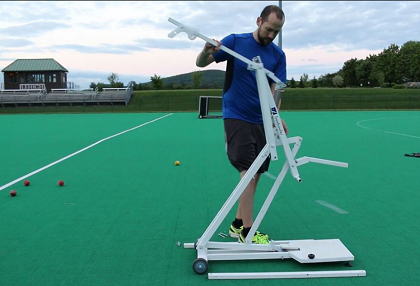
“We really wanted to be innovative the cricket market. Everyone’s going high-tech, we are going low-tech,” Justin said.
Usually, cricket bowling machines are quite expensive. In South Africa — where cricket bowling machines would be in high demand — a Paceman Pro Bowling Machine costs approximately US $932.
A new product ready to fly
Pratheek and Justin’s new mechanical engineering startup soon announced their eco-friendly, affordable answer to the bowling machine; they called it the Freebowler. The bowling machine is free from batteries, cords, and has no electricity ports on it.
What they produced was a purely mechanical product, fitted with a throwing arm operated via a spring, a ball cup, and more.
"The ball in the cup can be set at different angles and orientation using a knob that enables the batsman to play variations of lengths and swings," said Pratheek.
"The machine has wheels at the bottom to maneuver and is thus portable. It can be placed shorter than the normal 22-yard distance from the batsman. This way it enables the batsman to play different length and bounce at higher speeds."
The Freebowler costs approximately US $434. The Freebowler also matches, and in some cases, trumps other bowling machines' output speed: the Freebowler can launch balls at up to 140 kilometers per hour (87MPH). The Freebowler weighs in at only 23 kilograms. It's a perfect product for remote regions which do not have access to electricity or cannot afford conventional bowling machines.
The machine can take old cricket balls, new balls, indoor cricket balls, baseballs, and tennis balls.
Mechanical engineering for the betterment of sports could indeed be an area of growth with the Freebowler as the inspiration. The Freebowler website states:
“Machines that have this capacity to contort in a unique way, combined with an amount of storing convenience, environmental consciousness and adjustability not only show how far technology has come, but it also enhances the sport’s overall value.”
Works Cited
“Cricket Bowling Machine | Non-Electric Training Equipment.” Freebowler, freebowler.com/.
“This Startup Is Batting for Cricket Lovers with Its Portable Non-Electric Bowling Machine.” YourStory.com, 28 Oct. 2018, yourstory.com/2018/10/startup-batting-cricket-lovers-portable-non-electric-bowling-machine/.
As 2018 comes to a close, the industrial automation market is preparing to further digitize and automate industries into 2019.
McKinsey Global Institute (MGI) reports that by 2030 about 15 percent of workers around the world will be displaced by automation. However, they also note that employees are unaware that eight to nine percent of them will work in jobs that don't yet exist.
Consequently, automation will not only replace repetitive jobs, but also create new opportunities in many industries. This is why a culture of life-long learning is critical; a willingness to upskill and cross-skill.

Dean of Engineering at the Engineering Institute of Technology, Steve Mackay, believes emphatically that automation will preserve the engineer, not replace him/her. However, Steve notes that they should take responsibility for their futures, by being aware of the changes occurring in the industry.
"You may be doing something today, but tomorrow you will be doing something completely different," he said, in a lecture.
"The most important message is that you should commit to continuous professional development. Look for the job demands of the country you are based in and be open to opportunities to learn and skill up. Every country needs certain kinds of engineer - in fact - every town has its own particular demands.”
Global innovation requires engineers
What should educational institutions be including in their curricula, to ensure students are equipped to tackle Industry 4.0? How much on-the-job training needs to occur in industries that have introduced more automated processes into their businesses?
Those are essential questions that organizations are collectively asking. However, getting the average person interested and skilled in using new technologies is a tall order.
The World Economic Forum has invested in the construction of 12 Fourth Industrial Revolution centers around the world that will familiarize the public with the kinds of technologies one would and will see in the Industry 4.0 world.
Professor Klaus Schwab, founder and executive chairman of the World Economic Forum said:
"The centers are looking at eight different technologies, such as artificial intelligence, blockchain, drone technology, big data, precision medicine and so on, to develop the necessary ethical views, policies and regulations around these technologies which can be applied on a global level."
Schwab, in a recent video by WEF, commented on how unprepared the world is for the current digital revolution. He points out that it is those with technical backgrounds who are vital to the growth of the fourth industrial revolution, and perhaps a better world for all.
And workers with technical skills are more likely to circumnavigate the hollowing out of jobs that Industry 4.0 technologies threaten. CareerBuilder’s CEO Irina Novoselsky explains:
“Most of the fastest-growing occupations have a technical component to them. Workers across all job levels will need to continually pursue opportunities to upskill in order to maneuver around accelerated shifts in labor demand. This is a particularly pressing issue for middle-wage workers who are at greater risk of becoming displaced and workers in general who want to move up into better-paying jobs.”
The World Economic Forum's 2018 Future of Jobs Report aptly said that 54 percent of all employees will need ‘significant re- and up skilling' by the year 2022, to meet the changes coming to workplaces.
Works Cited
Ellingrud, Kweilin. “The Upside Of Automation: New Jobs, Increased Productivity And Changing Roles For Workers.” Forbes, Forbes Magazine, 23 Oct. 2018, www.forbes.com/sites/kweilinellingrud/2018/10/23/the-upside-of-automation-new-jobs-increased-productivity-and-changing-roles-for-workers/#276a7b1e7df0.
Letsebe, Kgaogelo. “WEF to Establish Industry 4.0 Centre in SA.” ITWeb, ITWeb, 28 June 2018, www.itweb.co.za/content/VgZeyvJAONaqdjX9.
Morgan, Hannah. “To Fend Off Your Robot Replacement, Reinvest in Job Training.” U.S. News & World Report, U.S. News & World Report, money.usnews.com/money/blogs/outside-voices-careers/articles/2018-10-19/warning-you-need-to-reinvest-in-job-training.
Is the move to electric vehicles on track?
Last year the UK government pledged that the manufacture of petrol and diesel cars would cease by 2040. In July, they then amended their pledge to also exclude hybrids (cars powered by electricity and petrol/diesel). MPs in the United Kingdom are, however, growing ever more skeptical about the viability of a majority electric vehicle future by 2040.
On the other hand, a new report has been released by the Business, Energy and Industrial Committee, ‘Electric vehicles: driving the transition.' They believe that the initial pledges by the government were ‘vague' and lacked ambition. They recommend that government ban the sales of fossil-fueled vehicles by the year 2032 and make the necessary investment to facilitate it.
Chair (and engineer) of the Business, Energy and Industrial Committee said:
“We cannot expect consumers to overcome ‘range anxiety’ and switch to electric vehicles if they cannot be confident of finding convenient, reliable points to regularly charge their cars. The government needs to get a grip and lead on coordinating the financial support and technical know-how necessary for local authorities to promote this infrastructure and help ensure that electric cars are an attractive option for consumers.”
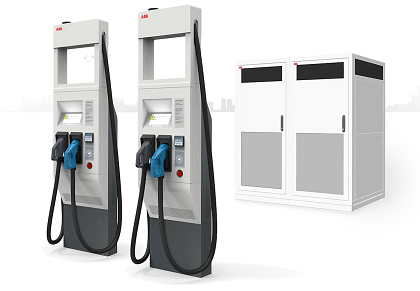
The technical know-how across many facets of the global rollover to electric vehicles will be an essential focus in the next few years. Training a league of engineers to focus specifically on electric cars is vitally important.
Electric Car engineering courses, and Hybrid and Electric Vehicle Engineering Academies are popping up fast to meet the potential skills shortage that the automobile industry might face as 2040 approaches. Despite these efforts experts worry that deadlines cannot be met for a 2040 deadline, let alone one in 2032.
Mike Hawes, the chief executive of the Society of Motor Manufacturers and Traders (SMMT), as quoted by Verdict UK, said:
“The government’s 2040 ambition was already extremely challenging, so to fast-track that by eight years would be nigh impossible. We said we need world-class infrastructure and world-class incentives to have any chance of delivering so the recent cuts to the Plug-in Car Grand and lack of charging facilities - both of which are severely criticized by the Committee - show just how difficult it would be to accelerate this transition.”
The overarching reason for lessening the number of combustion engines on the road is to minimize emissions. The current government ambition is named the ‘Road to Zero Strategy.'
The current situation
EV Volumes analyses the electric car market - it has reported that there were 3 million electric vehicles in operation worldwide, by the end of November 2017. Another 2 million are expected to be on the roads by the end of 2018.
ABB have, however, released a new electric vehicle charger called the Terra HP. It can run three times faster than the current EV chargers on the market and can also service two vehicles at the same time. The development of faster EV charging technologies will encourage consumers and potentially fast-track the uptake of EVs. ABB confirms that in just eight minutes 200km (120 miles) of driving range will be added to the latest EVs on their new charging stations.
Works Cited
“ABB Powers e-Mobility with Launch of First 350 KW High Power Car Charger.” ABB Group - Leading Digital Technologies for Industry, 24 Apr. 2018, new.abb.com/news/detail/4439/abb-powers-e-mobility-with-launch-of-first-350-kw-high-power-car-charger.
Migliorato, Lorenzo, and Christopher Marchant. “Government Committee Considers 'Road to Zero' Petrol Ban by 2032.” Motor Finance, 19 Oct. 2018, www.verdict.co.uk/motor-finance-online/news/government-committee-considers-bringing-petrol-ban-forward-2032/.
“UK Government EV Plans Vague and Unambitious Claim MPs.” The Engineer, 19 Oct. 2018, www.theengineer.co.uk/mps-criticise-uk-government-ev-plans/?cmpid=tenews_6443514&utm_medium=email&utm_source=newsletter&utm_campaign=tenews&adg=5A0EAC12-A7C5-4FD9-9AA8-84D6979695B5.
At this year's Dutch Design Week, the world's first 3D printed stainless steel bridge was unveiled.
The bridge was produced by a Dutch robotics company named MX3D. It will serve as a crossing over one of Amsterdam's oldest and most famous canals, the Oudezijds Achterburgwal.
Its construction utilized optimization software and a robotic additive manufacturing technology to layer molten steel repetitively. The traditional construction engineering approach to building a bridge has potentially been altered forever.
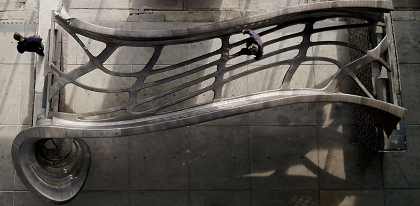
Six industrial robots equipped with ‘purpose-built tools' assisted in controlling welding machines that fused the bridge together. Reflecting on how the final design of the bridge changed, MX3D said:
“The initial design changed significantly due to the engineering concerns. The lightweight tree-like structure is built on four main bearers. The concern was that if one of these bearers gets hit by a boat, the structure could critically fail. Therefore a totally new concept was created that took into account everything we learned until then about the material, the local specifications and regulations.”
The bridge's structural integrity will be monitored via sensors, which will provide engineers with the data they need to ensure the bridge is structurally sound.
In a virtual space, the data will help build a ‘digital twin' bridge. A computer model will monitor the safety and performance of the bridge based on how many people have crossed it over time. This is something that structures around the world could benefit from. This technology allows engineers to simulate different situations to test out different stresses.
A new term is being coined in the midst of the technological development of bridges: smart bridges. MX3D is confident that construction robots will be widespread in the next five years.
"We have set a vision in which robots would be able to autonomously 3D print infrastructural interventions in our built environment," an MX3D spokesperson said. "The work on this 3D printed bridge will contribute to the future of safe, efficient and data-driven engineering by monitoring the structure as thousands of people and bicycles traverse the bridge hourly in place."
The feat of engineering won them the Dutch Design Award of 2018 in the Design Research category.
Works Cited
“MX3D Bridge.” MX3D, mx3d.com/projects/bridge-2/.
Yalcinkaya, Gunseli. “World's First 3D-Printed Steel Bridge Unveiled at Dutch Design Week.” Dezeen, Dezeen, 24 Oct. 2018, www.dezeen.com/2018/10/22/worlds-first-3d-printed-steel-bridge-completed-mx3d-technology/.
Are you planning to study towards a degree with EIT during 2019?
Our 2018 scholarship winners - students online and on-campus - are working hard, making the most of the windfall they received.
If you plan to study with us next year you should consider sending in your application very soon.

- If your preference is online study you need to be quick! You must have your scholarship application in by Friday 23rd of November, 2018.
- For those of you planning to study on-campus, you must have your scholarship application in by Friday 11th January, 2019.
How to apply?
Please see our Scholarship Page for eligibility criteria and application requirements.
Please contact Ms Caroline Mackay on
Rolls-Royce and Intel have joined forces to develop an Intelligent Awareness System for future autonomous shipping projects.
The first entirely unmanned, crewless ships, with the self-sailing tech, are set to hit the oceans in 2025.
Inevitably, they will see crewed vessels working alongside them.
Don’t assume that this technology has rendered the lighthouse useless though. In the official simulated pictures published by Rolls-Royce, the lighthouse remains the beacon announcing land that it has always been.
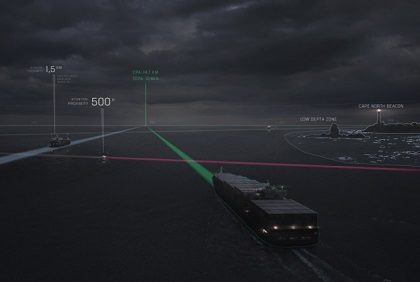
Nonetheless, the new system packs a punch in the technology department; the setup includes LIDAR, radar, thermal camera, High Definition cameras, satellite data and weather forecasts. With all of the data being generated by these technologies, Intel has fitted the system with their 3D NAND solid-state drives. The drives will store up to one terabyte of compressed data per day.
It’s possible that industrial-sized, autonomously controlled vessels could be greenlit by governments across the globe before autonomous vehicles! Only time will tell.
Kevin Daffey, director of ship intelligence at Rolls-Royce said:
“It presents an unparalleled situational awareness of what’s around the vessel to the watch-keepers on the bridge, including distances, the names of the vessels that are near them, or how far they are from land. Over the next three years we’ll begin to see the first commercially-operated ships with some degree of autonomous functionality on board, moving towards vessels that can make their own decisions from around 2025 onwards.”
A network of cameras with four interface modes will ensure security onboard these ships. The captain of the vessel will have 360 degrees of awareness, due to virtual reality, 2D and 3D, Augmented Reality and Precision mode.
When a ship is faced with a narrow route, the Precision mode utilizes the Rolls-Royce LIDAR system to measure distances between the ship and any obstacles. The Augmented Reality mode overlays graphics on a live camera feed provided with Intelligent Awareness sensors. The system recognizes markers and allows the captains to track virtually anything standing in its line of sight.
On the Virtual Reality and 2D and 3D maps, real-time awareness data is fed to the ship's systems. It gives the crew much more visibility and acts like a more sophisticated version of Google Maps. In the Costa Concordia shipwreck of 2012, the onboard radar technology was turned off by the captain who was sure he could use sight alone to navigate. With the new Rolls-Royce and Intel matchup, relying on the automated sailing software will be paramount for the onboard staff.
In time, however, the onboard staff will not be needed — the ships will drive themselves.
Works Cited
Vincent, James. “Rolls-Royce Is Partnering with Intel to Make Self-Driving Ships a Reality.” The Verge, The Verge, 15 Oct. 2018, www.theverge.com/2018/10/15/17979252/self-driving-autonomous-ships-drones-intel-rolls-royce-partnership.
Innovation is sometimes all talk and no action. What actually gets engineers inventing and creating novel solutions to everyday problems? Handsome rewards, of course. The James Dyson Award is an international design competition that ‘celebrates, encourages and inspires the designers of new problem-solving ideas.'
A curious advent of engineering design has already won a team of engineers the Australian Dyson Award. They are now in the running to win the international James Dyson Award. These engineers managed to reinvent the tape measure, to showcase one defining characteristic: its accessibility to the visually impaired.
They are calling it the Macaron. The tape measure interfaces with a smartphone app that utilizes Bluetooth and audio feedback to assist with the measuring process.
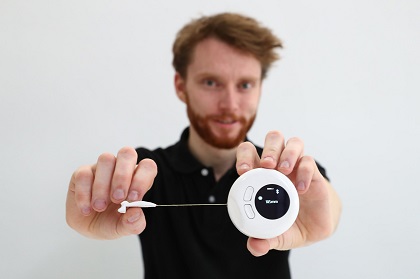
The engineers explained that the tape measures accurately, records and stores your measurements. Inbuilt audio then reads them out.
The four engineers behind the design are Jake Dean, Yuma Decaux, Woo Sung Jung and Weng Hou Chan from the Queensland University of Technology. Team member Yuma Decaux is blind and served as their inspiration to invent the tape measure.
"Yuma would come in to the servo a lot and we'd talk," said Jake Dean.
"He wanted to be able to renovate his house but specialized talking tape measures on the market were expensive, and couldn't find anything that suited what he wanted to do."
In 2012, it was estimated that there were 285 million visually impaired people in the world. New technology, or novel applications of technology, could be used to improve their lives. The engineers believe that the work they are doing under their startup, OSeyeris, will help visually impaired people find employment in industries they otherwise would have never been eligible for.
"People with little to no vision need to rely heavily on specialized measuring devices, but we hope that the Macaron will become the common and everyday household product that leads to a new way of measuring, recording and thinking," said Dean.
"Our team is so excited to be recognized for this year's James Dyson Award and can't wait to see what the future holds for the device."
The Macaron may just become the tape measure of choice for everyone.
Works Cited
Award, James Dyson. “James Dyson Award (@JamesDysonAward).” Twitter, Twitter, 18 Oct. 2018, twitter.com/jamesdysonaward?lang=en.
QUT. “Student Digital Smart Tech Measures Up.” QUT, QUT, 7 Oct. 2018, www.qut.edu.au/news?id=136528.
Brian Masemola graduated high school in 2006. By 2007, he had joined a college and started studying Instrumentation, which led to an apprenticeship with Anglo American Thermal Coal in 2009. In 2012, he qualified as an Instrumentation Mechanician after completing his National Diploma in Instrumentation.
In 2016, he joined the Engineering Institute of Technology, pursuing an Advanced Diploma in Industrial Automation. Brian had subsequently unlocked a new community of engineers he had never come across before.
“I met people from various countries. It was awesome! We networked, exchanged information and shared experiences. EIT’s set-up is great and convenient — especially for someone in the working class. It’s always awesome for the fact that classes are attended in the late evenings, it is a comfortable space for the learner.”
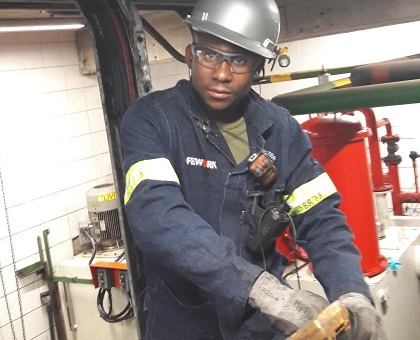
He is currently working in the chrome smelting industry, where his daily responsibilities include the installation and commissioning of new instruments. He also assists with the maintenance and breakdown attendance of the raw material, pallets and kiln section. He says that the industry is undergoing technological growth in Control & Instrumentation in respect to safety of personnel and safeguard machines.
Now, he is working at one of Glencore’s chrome smelters as an Instrumentation Technician. And he is a proud EIT graduate. He said:
“Today, I’m an Advanced Diploma graduate and still looking for better opportunities and pursuing my studies with EIT. I am looking to work towards getting a Masters.”
Brian notes he has amassed very useful knowledge during his time in the course. While he was studying through EIT and employed in a position at work, he figured that he could strike the perfect balance of work and studying.
“I drafted a little time table. I allocated times for working, studying and resting — with break intervals included,” he said.
Brian notes that the motivation to keep studying and leveling up in his industry comes from seeing the success of the new generation of engineers filling high level positions in companies around the world. He is aiming to ascend to those high level positions too. He says he also wants to become so proficient in engineering that he can eventually invent something useful for the betterment of mankind.
On the 18th October the Engineering Institute of Technology (EIT) hosted their 2018 African Graduation Gala, in South Africa.
Almost 60 graduates attended; having completed either a Master of Engineering degree or an Advanced Diploma, and in a couple of instances, a Professional Certificate course.
Despite the tyranny of distance, the EIT graduates who were able to attend hailed from ten African nations: Chad, Ethiopia, Uganda, Tanzania, Botswana, Namibia, Zambia, Zimbabwe, Angola and South Africa.

The live, online platform of learning reaches EIT students in their homelands around Africa (and indeed the world). The graduates’ discipline, persistence and determination were applauded; the vast majority of them have studied while working full time.
The 2018 graduates were addressed by the CEO of the South African Council of Engineering (ECSA), Mr Sipho Madonsela and Mr Johan Maartens, the CEO of the Society for Automation, Instrumentation, Measurement and Control (SAIMC).
Both gentlemen expressed their support for an education which contributes to the betterment of the learners and to the industries in which they work. They also exhorted the graduates to continue to learn and to remain abreast of ever-changing technologies, in an age marked by the Fourth Industrial Revolution.
Addressing the graduates at the ceremony, CEO of ECSA, Mr Madonsela said:
“You are party to a revolution whether by commission or omission which is enhancing engineering didactics on the concept of technology. Not only have you been equipped with the means to transform the natural world, you yourselves have been through a process that is transforming the deployment of technology in engineering education.”
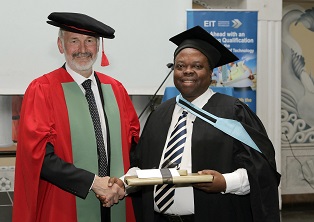
The graduation ceremony, in quintessential South African fashion, included ululations and jovial celebrations.
The Dean of Engineering at EIT, Dr Steve Mackay, honoured some of the college’s most dedicated students and urged them all to maintain their integrity; even when it required them to choose the more difficult path.
The Graduate of the Year, Johannes Kapeuasha, joined the proceedings via webcam from Namibia; he spoke admiringly about how EIT had contributed to his promotion from security guard to industrial security technician.
One of the runners-up is a future female engineering superstar, Jo-Ann Hogan. She commented that there were times during her course when she thought she would not finish; her excitement for what the future holds was plain.
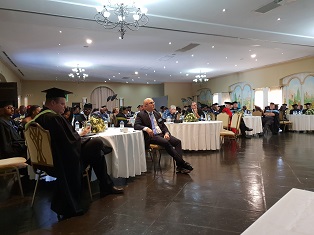
The EIT Honorary Student of the Year is a Zimbabwean student, Algate Panyika Mtemah. Algate, amidst Zimbabwe’s politically complicated year, assisted students with transferring money from Zimbabwe to South Africa to pay for their tuition fees.
The day ended with a lunch and a networking opportunity for the many proud graduates and family members who attended.
EIT alumnus Allan Butler conducted a presentation on “Ethics in Engineering” for our students at our East Perth campus last Thursday.
Allan, who is currently a SCADA Engineer at Australian Gas Infrastructure Group, graduated from EIT’s Master of Engineering (Industrial Automation) in 2018. His main role is to manage the SCADA system at the Dampier Bunbury Pipeline.
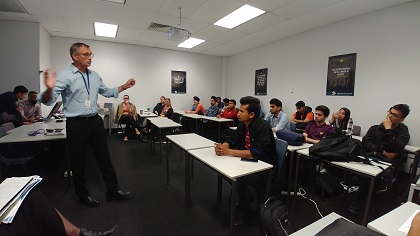
EIT is committed to delivering education programs that are aligned with real industry needs. We also want our students to have ongoing access to relevant information, so they can continue learning and improving well into their career. As a result, we’re collaborating closely with industry to bring our students relevant guest speakers who can provide meaningful technical insight.
With over 20 years of experience in the engineering industry, Allan was able to share his advice about life beyond the classroom.
His presentation started with a question: “Would you rather take a 50% chance of getting the problem correct and $1 million, or a 99% chance of getting the problem correct and $10?
“If you said 50% and $1 million, you can stand and leave.”
With a focus on ethical decision making throughout an engineer’s career, Allan then talked about avoiding disaster when a project goes wrong.
“The only way to remove any uncertainty is to remove the doubt,” he said.
“As an engineer your ability to question and simplify the most complex and critical issues you face will prevent a disaster.”
He encouraged the students to own their signature and warned against signing off on a project if they’re not completely certain there are no problems with it. He reminded them that the public puts their faith in the engineers’ abilities to keep them safe. For example, most people don’t expect structures such as bridges and buildings to collapse at any moment.
“Your signature is your word that you have agreed with a statement of engineering fact. Time, money and ignorance is not an excuse for signing off on poor design or recommendation.”
He also emphasized the importance of taking control of your own educational experience.
“Your lecturer gives you a series of questions followed by examples and maybe the answers. Your lecturer is only responsible for half of your experience.
“Your job is to help yourself and your class mates. The question you ask is possibly the one everyone else was considering.”
To listen to the recording, click here.
Martin Mutale works in the mining industry.
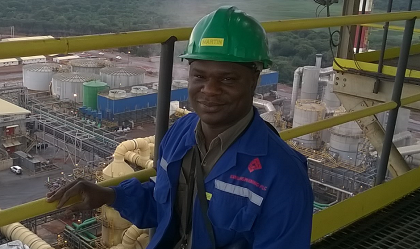
He began his career with a craft certificate in electrical systems. After working for five years, he pursued a diploma in electrical engineering at a university in Zambia, which he did not complete.
After another seven years in the industry he realised that he had to upskill. Through the Engineering Institute of Technology (EIT) Martin now has two qualifications, a Professional Certificate in PLCs and SCADA Systems and an Advanced Diploma of Applied Electrical Systems.
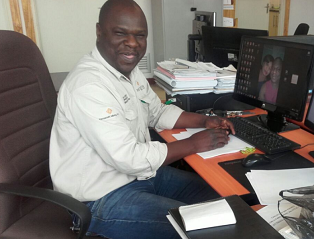
Mutale is proud to claim that he can ‘design and develop a project to completion’ with the skills he has gained through work and study. It is also clear, however, that his love for the industry enables him; he describes his project work as fascinating, ‘from installation to commissioning.’
Mutale notes that the flexibility of EIT’s training curriculum allowed him to study and work at the same time. When he understood that he needed to gain professional development, he also knew he had to continue to work; finding EIT facilitated both.
Martin has always regarded a career in engineering his dream. He believes that studying through EIT was merely a logical step towards furthering his ambitions in the field. He said:
“Throughout my working years, I have been exposed to a lot of engineering systems and yet I had no higher education. When I shared this with my wife, she was like the one doing the course - she was so supportive! The day I started learning, that was the day I started applying the skills EIT equips you with.”
Martin is now mulling over the possibility of pursuing his Bachelor of Science in Electrical Engineering. He notes, however, that in order to do this he needs to find the correct balance between being a father and studying.
Marcel Maughan is an Automation and Breakdown Specialist for a company named IMP. The company is a world leader in automating sample preparation and analysis equipment for mining and sample laboratories. His responsibilities include installing, servicing, and repairing the automation equipment at IMP.
A career in automation, however, has been quite the journey for Marcel. He completed high school in 1997, with a dream of becoming an Electrical Engineer. The only snag was his family could not afford to send him to university. Instead he decided to find work. Reflecting on that time in his life, he said:
“Unfortunately my dreams seemed to be out of reach. I applied for many jobs and went for many interviews without success. For three years I was unsuccessful in every application, but I worked day and night as a barman and later as the bar manager. I made just enough money to pay rent and do a semester at college, where I studied Electro Technics and Industrial Electronics.”
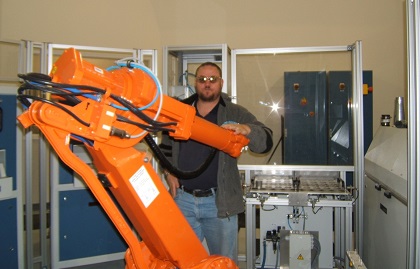
His persistence and hard work helped Marcel eventually get his foot into the right door. In March 2000 he found employment with IMP where he was employed as a Junior Technician. During this time he pursued a Certificate of Compliance for Force and Mass Metrology which qualified him as a Metrologist.
Thereafter, but still with IMP, he was recruited onto an automation project. He was hooked and knew he wanted to be in automation for the rest of his career. His hunger for knowledge was realized by IMP; they sent him on various PLC and Robotics courses. He even completed an advanced course in Robot programming.
His next course was a Profibus Installers course which qualified him as a Profibus engineer. These accumulated achievements won Marcel his Senior Automation Technician status.
About the ever-changing automation industry, he said:
“The automation industry is constantly changing. More and more people are turning towards automation for safety and production reasons. The most fascinating part is being involved in the Automation evolution.”
But there was no slowing Marcel down, in 2011 he completed his Electrical trade and became a qualified Electrician.
In 2016, wanting to augment his professional development, Marcel stumbled across the Engineering Institute of Technology (EIT). His employer agreed to assist him and he registered for the Advanced Diploma in Remote Engineering, Mechatronics and Robotics. 18 months later he completed his final assignment and received his qualification.
He believes his studies have been enhanced because of his solid and ongoing experience in industry.
It seems that striving for excellence and determination are the key: Marcel is an example of how these qualities can elevate someone and then assist him/her to continue to improve exponentially. He said:
“Success comes from doing it right. The FIRST time! And on time! If you do this in all your tasks you gain a sense of pride in what you do. If that can’t motivate you, then there will be few things that will.”
He has some advice for students and engineers determined to improve as practitioners in the engineering world.
“Experience is probably the most valuable aspect of your career. Second to this is studying and learning while gaining experience. I am determined to continue to learn and gain more experience as I go. In terms of furthering my studies, Electrical Engineering will be my main focus.”
Murray Langley attended a career exhibition during his final year of high school. He came across a stall run by the South African Institute of Measurement and Control (SAIMC) and knew that he had found what he was looking for. He applied for a trainee position in the Instrumentation and Automation field with Iscor Ltd (now part of the steel company Arcelor-Mittal). He filled the position straight out of high school and has never looked back.
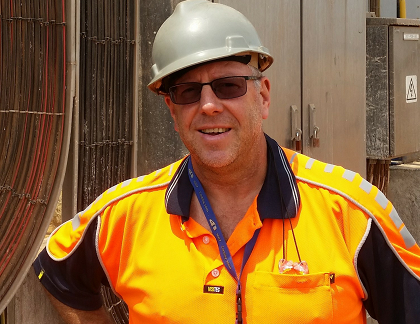
He began further studies in 2011 and has completed an Advanced Diploma, two Graduate Diplomas, the Master of Engineering (Industrial Automation) and more recently embarked on a Master of Engineering (Electrical Systems) - all though the Engineering Institute of Technology (EIT).
Throughout his career Murray has worked in the Steel and Aluminum Smelting and Mineral Sands mining industry. Currently though, he is working in the Democratic Republic of Congo (DRC), at the Kamoto Copper Company (KCC). His responsibilities include E&I Engineering and the daily management of contractors who are building the E&I component of KCC’s copper precipitation plant.
In the last three decades, Murray has seen automation within the industry evolve. He said:
“Over 35 years in the Instrumentation, Automation and Control industry, I’ve worked with pneumatic instruments and controllers and mimic panels covering control room walls. I have been involved in automation upgrades, Smart MCCs, networked instruments and state of the art control rooms. It has been a fantastic journey.”
Murray asserts that his studies through EIT have been part and parcel of his professional development over the past 7 years. Balancing work and studying took dedication and commitment. When asked about what motivated him through his many qualifications, he said: “The sense of achievement when I finish what I have started”.
Sebastian Govender works for oil giant Saudi Aramco. He works in the Project Management Division, in Mega Projects in the Oil & Gas industry, in Jazan Economic City.
When he began working in Saudi Arabia, in 2013, he worked on the Jazan Refinery Mega Project. He was on the Project Management Team as an instrumentation engineer, specializing in Detail Design. He then moved over to PMT Construction. He currently manages the construction/pre-commissioning for E&I in the Gas Treatment Unit (GTU).
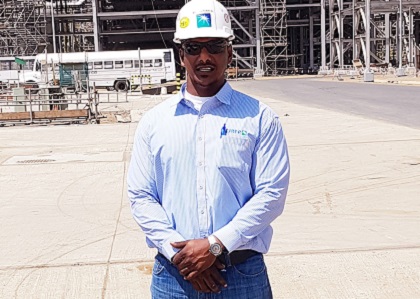
For him, the most fascinating developments in the Oil and Gas industry have occurred in the ever-evolving process control systems, which, he says, have made life a lot easier in the refinery.
On why he pursued a career in Oil & Gas, Govender said:
“The reason I have chosen to work in the O&G industry is because I love the ongoing changes in technology of refining, and the challenges faced in the day to day operations. I love the environment, being surrounded by engineers sharing ideas and troubleshooting - and the passion I have for what I do is motivating.”
Govender studied the 52684WA - Advanced Diploma of Electrical and Instrumentation (E&I) Engineering for Oil and Gas Facilities through the Engineering Institute of Technology (EIT). He had searched far and wide for an accredited institution that would allow him to study remotely. He said:
“I am South African and working abroad makes it difficult to study and work due to leave needed for examinations. I then came across EIT online while searching - finding this institution was the best thing that ever happened to me (except for finding my wife and having our daughter). The training I received was exceptional for an online platform. The LABs and the lecturers were very informative and hands-on.”
And what is Sebastian’s next study plan? To gain some professional development on EIT’s Professional Certificate of Competency in Project Management for Engineers.
Despite his commitment to online learning he admitted that studying whilst working takes a level of motivation. This is driven by his passion, he says:
“My motivation comes from the passion I have for engineering, construction and interacting with the diverse people you meet in the industry. If you love what you do, you are never bored and never have any negative vibes in the work environment.”
Both men recently visited a number of countries, taking with them the passion for education and engineering that marks the Engineering Institute of Technology (EIT). They have travelled to share the opportunities EIT offers students who want to further their engineering studies, or who dream of becoming engineers - online or on campus in Perth, Western Australia.
Rolf and David will have packed many facts about EIT’s learning platform and approach into their deliveries. For instance, that EIT’s teachers are engineering experts from all over the world. And that they reach students in real time – whether they are on campus or online. They would also have spoken of EIT’s course content – that it is driven by the needs of industry and designed (and indeed re-designed) to be relevant, practical and useful.
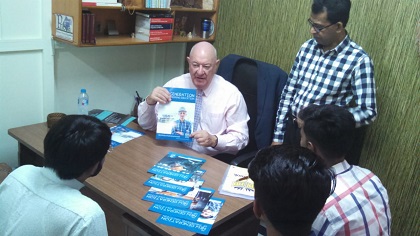
Rolf Baum, EIT’s International Recruitment Manager in the South Asia region, recently visited India and Pakistan to gauge the hunger for knowledge in the next generation of learners in those countries. He focused on EIT’s innovative course delivery and on the personalised support that students receive. He said:
“EIT is the only Australian Government approved Independent Higher Education Provider delivering courses in this discipline. We at EIT have a lot to offer international students through our extended experience and specialization in this industry.”
David Gadjus, our International Education Manager for the regions of Africa and South America, has also been globetrotting, having recently visited Lagos in Nigeria - the fastest growing, and most populated city in Africa.
There he visited the Engineering Faculty of the University of Lagos - meeting with their Dean of Engineering who is also the president of the African Engineering Education Association. Students were full of questions about EIT, but with the option of studying on campus, they were also eager to learn about student visas and the cost of living in Australia.
Moving on to Abuja Port Harcourt, David spoke to those already working in the industry, but considering opportunities to up-skill or gain professional development. He outlined the benefits EIT could bring to their workplaces. Then in Accra in Ghana, EIT held a recruitment seminar, where David presented to students who understand the value of education and who have a love for engineering and technology.
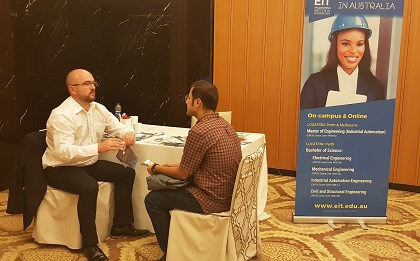
Then David went transcontinental. He traveled to Istanbul in Turkey. He said:
“An interesting fact, in the first day of meetings, I had one meeting in Europe, and one meeting in Asia!”
Istanbul is the only city in the world that is spread between two continents. He gained useful insights into Turkish educational markets. Together with Austrade and a number of Australian diplomats, EIT presented to students attending some of the best schools in Turkey. David also participated in the IDP Showcase event. IDP is the largest educational agency in the world.
Rolf Baum, on his side of the world, concluded:
“It was wonderful to be on the ground working closely with our quality partners. It was also good to chat to potential students; on the benefits of studying in a wonderful country like Australia and in a discipline that is critical – globally - today and in the future...and sharing how they could be a part of shaping that future.”
Baum went on to talk specifically about Perth, on the west coast of Australia:
“Having worked on the east coast for much of my career I have come to realise that Perth is a hidden gem, one which I wish I had discovered earlier. It provides the perfect setting for international students and offers a large range of benefits that our agent partners are now able to present to prospective students.”
For students interested in on-campus study, please contact
Just across from EIT’s sister company in South Africa, in Waterfall City, Midrand, the largest rooftop solar photovoltaic (PV) system in the southern hemisphere has been unveiled.
If there’s one thing that South Africa doesn’t lack, it’s sunshine. Malls and other venues that keep the lights on around the clock are moving towards renewable energy to reduce their carbon footprints. It also provides a model for the country; encouraging the citizens of South Africa to dream of and plan for a future where clean energy makes up one hundred per cent of the energy mix.
Engineers from renewable energy company Solareff have fitted the Mall of Africa’s roof with a US $3.49 million photovoltaic system that will generate the necessary energy to keep the lights on.
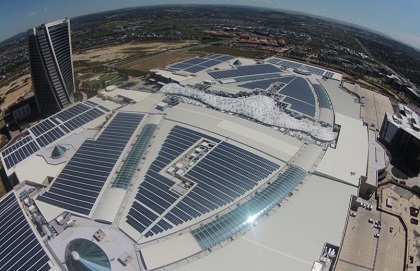
It is officially the 10th most significant photovoltaic solar setup in the world, and purportedly the world’s first mixed-use integrated solar power-diesel hybrid system.
Talking to IOL, Michael Clampett, the head of retail asset management at Attacq, the company who owns the mall, said:
“This project will see the mall producing sufficient power to support its day-to-day electricity requirements while also decreasing its overall carbon footprint, another significant point in our sustainability journey.”
It is expected to generate 7800 MWh every year. Attacq also mentioned that the system would equate to 157 fewer coal trucks on the road annually. The setup covers 4.5 hectares, taking up most of the space on the Mall’s roof. And Mall of Africa is not the only mall making the transition.
Liberty Midlands Mall in Pietermaritzburg, KwaZulu-Natal, has confirmed that they too will be using clean energy in their mall. According to eProperty, the solar plant will consist of 2,900 grid tied; roof mounted photovoltaics made out of premium Monocrystalline silicon chipped photovoltaic cells.
The system will power the mall during the hours the sun is in the sky. South African private energy companies are looking to introduce industrial-scale battery storage that would enable storage of solar energy so clean energy can be utilized around the clock.
The South African government has just announced an Integrated Resource Plan. It suggests that the government will prioritize renewable energy projects and providers.
And this is not surprising - South Africa’s state-owned utility is struggling to keep up with electricity demand. The photovoltaic system on the Mall of Africa, therefore, is particularly important as it will ensure more electricity is available for surrounding businesses and housing.
Works Cited
“Mall of Africa Just Installed the World's 10th Biggest Solar Roof - Here's What It Looks Like.” Here Is How Far Soccer Players Run during a World Cup Match, www.businessinsider.co.za/mall-of-africa-just-installed-the-worlds-10th-biggest-solar-roof-2018-9.
News, eProperty. “LOGIN.” Solar Project Set to Deliver Clean Energy to Liberty Midlands Mall - EProperty News, www.eprop.co.za/commercial-property-news/item/21331-solar-project-set-to-deliver-clean-energy-to-liberty-midlands-mall.html.
This week the Engineering Institute of Technology (EIT) received some important visitors. A delegation of three (the CEO and two supporting managers) from the Engineering Council of South Africa (ECSA) spent two days at our head office and on our campus in Perth, Western Australia. ECSA is the equivalent of Engineers Australia, but with greater regulatory power.
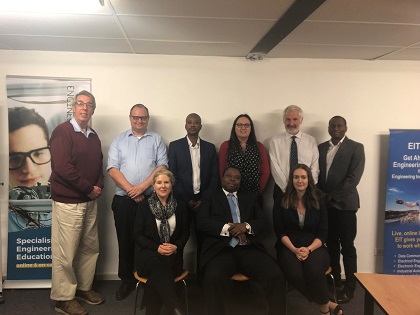
Back row: ECSA Council Member, Mr A Sentsho (third from left), Dean at EIT, Dr S Mackay (second from right), ECSA Executive Researcher, Mr M Gwazube ( end at right)
Their mission was to learn more about the online and blended learning platforms available for engineering education. The result of their research will be two-fold. South African education institutions can look forward to a robust set of protocols and standards on which to base their online learning methodologies. And those students unable to study on campus can look forward to an effective online education in engineering.
With a rapidly growing population the vocational and higher education institutions in South Africa are struggling to accommodate students of engineering. The option of expanding existing campuses, or building new ones, cannot be considered at this stage.
With this in mind Mr Sipho Madonsela, CEO of ECSA, explained that the wake-up call for regulators came with the student-based fees-must-fall campaign. In 2015 students began demanding free education and the resulting upheaval meant the universities had to abandon their lectures during those critical months leading up to the end of year exams. Many proactive and innovative engineering departments began offering lectures online to students unable to reach the campuses because of the student blockades. The efforts of the departments, however, were at best chaotic.
For Mr Madonsela, his colleagues and engineering Deans around the country an alternative approach is required; an approach methodically researched, planned and regulated.
We at EIT were delighted to show-off our online and blended platforms of learning to the ECSA team. Our students, based in over 100 countries, access a range of engineering diplomas, bachelor or master degrees, while they work.
We showcased the live, interactive sessions presented by our large pool of engineering practitioners and lecturers from around the world. They stream into the on campus classrooms and onto the computers of those students studying online; providing a ‘virtual’ forum where students and teachers can meet and discuss the content of their courses.
The ECSA team noted the benefits of EIT’s Learning Support Officers who are dedicated to the welfare of the remotely-based students.
They also became a little more familiar with EIT’s virtual and remote labs that interface with real equipment and which the students use to apply their learning. The inextricable link between engineering and technology means the internet has become a key part of modern engineering education and offers equivalence to physical delivery modes.
The ECSA team appreciated the importance of EIT’s remote invigilation software which was developed in house (and which continues to be honed in collaboration with Curtin University). It ensures student integrity - fundamental to quality education, whether delivered in a classroom or online.
EIT was honoured to host the ECSA delegation. We look forward to furthering the association as the Council prepares the online standards for South African engineering education.
The fourth industrial revolution is disrupting so many engineering industries, the civil engineers are beginning to call it ‘Civils 4.0.' Mark Hansford, writing for New Civil Engineer, says the industry is on "the cusp of a technological revolution."
In a year of high-profile bridge collapses, the civil engineering industry has seen more disparaging headlines than it is comfortable with. Something needs to be done within the industry to ensure these catastrophic failures don't occur.
In 2018, innovative and pioneering methods of construction alike have been nitpicked after highly publicized failures have occurred. The first incident that had engineers scratching their heads was in May when the Florida International University Bridge collapsed onto a highway.
Then in August the Morandi Bridge in Genoa came down. In the first case, innovative methods of construction known as ‘Accelerated Bridge Construction’ saw some criticism. But Hansford says the highly publicized failures are no reason to prevent further innovation in the industry.
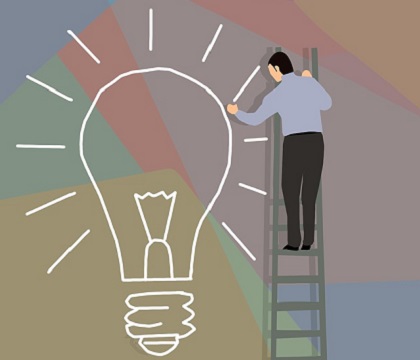
"Both collapses speak volumes about the support, both in design and delivery and then later, in operations and maintenance, that is needed to encourage innovation," said Hansford.
"Innovation is, by definition, doing the untried: the untested. Doing it is an inherently risky business and needs good support networks. But we need to do it. The art and the beauty of civil engineering is to innovate and evolve. It is also what the government is demanding, as we attempt to boost productivity in our sector.”
If the world were to criticize an innovative advent of technology in the engineering world based on one highly publicized shortcoming, innovation could cease to exist. It would be similar to avoiding nuclear power because of Chernobyl. Most informed individuals agree — innovation should not be stifled. While bridge collapses are bad, engineers need to continue innovating in the industry to ensure tragedies don't happen. This includes testing out new methods that could produce sturdier bridges in less time.
The startups are coming
A new culture of civil engineering is rising — a digital culture. The digitizing of the industry is inevitably snowballing as big data, machine learning and more infiltrate and disrupt. Naturally, new startup companies trying to capitalize on the digitization of the industry spring up to meet the demand for new efficiencies.
The New Civil Engineer’s Festival of Innovation and Technology happening on the 19th of September works with an accelerator program to help these kinds of startup companies out. The event has been organized to find the most promising startups in the civil engineering industry and assist with developing new, innovative ideas that can benefit the industry.
Below are some of the shortlisted participants who are close to getting real assistance with growing their companies into something that could change the civil engineering industry — or at least make it more efficient.
- Qualis Flow: They use the Internet of Things to better manage the impacts of construction. They aim to help businesses manage their resources more sustainably on construction and development sites, by gathering the data to support day-to-day decision making.
- Gear Buddy: They provide Internet of Things devices and a digital collaboration platform to help equipment suppliers, contractors, and equipment users connect more easily.
- nPlan: They help create complex construction schedules that build the cities of the future. Through deep learning and optimization methods, they create more efficient construction methodologies and scheduling for companies.
- CO-YOU: This startup has a plan for cleaning up the waste produced on construction sites. They are trying to get a construction packaging material patented that will absorb CO2 and biodegrade after use.
- Enable My Team: They have developed an automated asset recognition system that uses high-quality images that will assist in railway operations. "It will take this data and through AI and machine learning detect potential faults before they happen, allowing rail engineers to spend more time proactively mitigating risks rather than reactively fixing failures."
Works Cited
By Mark Hansford. “Five Game-Changers Picked to Present at TechFest.” New Civil Engineer, www.newcivilengineer.com/latest/five-game-changers-picked-to-present-at-techfest/10035151.article.
Hansford, 17 September 2018Mark. “Setbacks Should Not Prevent Us from Innovating.” New Civil Engineer, www.newcivilengineer.com/tech-excellence/setbacks-should-not-prevent-us-from-innovating/10035226.article.
September has come and gone, and it has given us something to contemplate as we venture towards the final three months of the year.
Investigative journalism show, Vice aired an episode in September entitled: Engineering Earth.
The episode alluded to the fact that engineers and scientists are looking to a new era of geoengineering as a ‘last ditch effort' to mitigate the effects of global warming. The report asserted that a technological revolution may be necessary to curb the phenomenon of global warming.
Vice founder Shane Smith said after 50 years of research, engineers and scientists are aware that the level of carbon dioxide present in our atmosphere ‘exceeds levels that haven't been seen in three million years.' He said the world is clearly past the point of no return.
Visiting Greenland's Eagle glacier — a glacier that has experienced immense runoff — Smith spoke to Jason Box, a PhD contributor to Vice and a member of the Geological Survey of Denmark and Greenland. He said:
"On average over the last 15 years, the loss rate from Greenland would give all seven and a half billion people on the planet a bathtub of water every day. Even halting emissions now, we still have this problem of 50 per cent too much CO2 in the atmosphere. Plan A, which was conservation, has largely failed. Plan B, geoengineering, needs to become Plan A it seems. Can we technologically take control of this car that is spinning out of control and start driving in the right direction?”
So how can engineering technology and scientific endeavor work to circumnavigate the inevitable?
Potential solutions
Engineers and scientists are considering geoengineering. It is defined as the deliberate large-scale manipulation of an environmental process that affects the earth’s climate, in an attempt to counteract the effects of global warming. It could also be earth’s last hope.
Applied Physics Professor at Harvard University and author of the book: A Case for Climate Engineering, David Keith, has formed an engineering startup that is dedicated to developing technology that could suck carbon dioxide out of the air.
They have been working on a direct air capture plant that removes carbon dioxide from the air since 2015. There seems to be healthy competition in the direct air capture industry too. Other companies have come out of the woodwork to design their specially crafted technology, engineered to make capturing carbon dioxide air cheaper and more efficient. One company, Climeworks, bravely announced the world's first commercial carbon removal technology in 2017.
Keith told MIT Technology Review:
“One of the reasons I’m particularly interested in developing the possibility of solar geoengineering is that it does appear that the benefits are most felt by the poorest. And that's because the biggest climate impacts — particularly impact from extreme heat and extreme precipitation events like tropical cyclones — fall on the world's poorest. There is now pretty clear evidence that solar geoengineering would be remarkably effective in reducing some of those risks, and the relative benefits would go more to the poor than to rich.”
Keith also said finding technological methods to reflect the sun off the surface of the earth is essential to work.
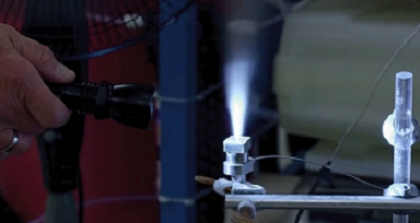
In Alaska, scientists are working with hollow glass microspheres hoping to exact Arctic restoration. The scientists say there has been a loss of the reflective heat shield in the Arctic. The reflective microspheres act as a reflective sand that offsets the sun beating down as hard as it usually does on the earth.
In Silicon Valley, engineers are working around the clock to find technologies that could keep the earth surface cool by brightening clouds. Armand Neukermans, engineer and physicist - and his team of engineers - are working on the technology that could improve clouds’ reflectivity at sea. The process is called marine cloud brightening, which includes spraying salt water into the sky to brighten clouds.
The engineers say an engineered nozzle could be fitted on ships at sea. These nozzles would emit salt particles and fuse with clouds hanging over the sea. The brightened cloud would reflect more sun off of it. Rising sea temperatures could be a thing of the past.
They also note that the possible adverse side effects could be less desirable. The impact of ongoing cloud brightening is being conducted by scientists around the world. That is the current balance that must be struck in geoengineering projects - the potential negatives that messing with the climate technologically could produce. Thus, the ethics behind companies who want to take on geoengineering projects need to be closely monitored.
Works Cited
“Engineering Earth (Preview) | VICE on HBO.” YouTube, 10 Sept. 2018, youtu.be/4iLhMV30S2o.
Temple, James, and James Temple. “This Scientist Is Taking the next Step in Geoengineering.” MIT Technology Review, MIT Technology Review, 27 July 2017, www.technologyreview.com/s/608312/this-scientist-is-taking-the-next-step-in-geoengineering/.
As we rapidly move through our first year of hosting on-campus students, we are consistently experiencing lots of ‘firsts’. In their first year of study, our students take part in a site-visit to gain a little insight into the engineering industry they have chosen.
CELEBRATION OF SUCCESS
Recently, one of our first-year Bachelor of Science (Civil and Structural Engineering) students, Hamza Baig completed his first industrial site-visit. I had the pleasure of interviewing Hamza, who was very excited to share his experience.
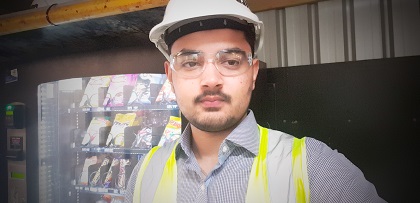
How did you know which companies to contact?
I went through the ‘top Australian companies’ contact list provided by the unit co-ordinator and highlighted those in Perth.
I then used the template letter on Moodle and sent Pro Build an email, introducing myself and requesting a day on-site. Within a very short time they replied, providing me with the site-manager’s details, who then put me in touch with the site co-ordinator. We confirmed and agreed I would be there at 9am, on Tuesday 11 September 2018.
Were you asked to wear any specific clothing?
I was asked to wear a long-sleeved shirt, long pants and safety boots. I explained that I did not have safety boots, and fortunately they had a spare pair I could borrow for the day.
How did you identify yourself when you arrived on site?
I wore my EIT student card around my neck. Both the site manager and the co-ordinator were interested in who EIT were, as they had not heard of our college. I explained that we are a well-established online engineering college, but that the campus in Perth only opened at the beginning of the year.
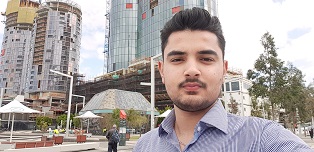
How did you spend your time on site?
I had the opportunity to visit two sites — one was a 35 floor apartment building currently being built at Elizabeth Quay, and the second was the Ritz Carlton Hotel site, next door, which has over 300 rooms.
I was provided with a hard hat, safety glasses, boots and a hi-vis jacket. I spent the day with two different site co-ordinators who were very happy to answer my many, many questions. They were very informative and I was also able to observe their meetings, where I met the site manager, who had ‘BOSS’ written on his hard-hat. He was also asking me questions about EIT.
I was surprised to learn there are so many different jobs for Civil engineers – covering IT, project management and design. The site office controlled and scheduled the work for the day. There were safety inductions and step-backs to identify safety risks.
Did this site-visit present any future opportunities, such as internships?
The ‘boss’ asked me how long I had been studying. He told me that when I am in my second year, there would be more opportunities for me to apply for an internship with their company, as they take on vacation internships over the college break. I will be in touch with him next year.
A new report from the Australian Bureau of Statistics (ABS) shows female engineering graduates earned slightly more than their male counterparts for the first time in 2017.
These figures account for males and females who have completed an undergraduate engineering degree and have started in their first full-time role. According to the report, the median starting salary for female engineering graduates is $65k. For male engineering graduates, the median starting salary is $63.5k.
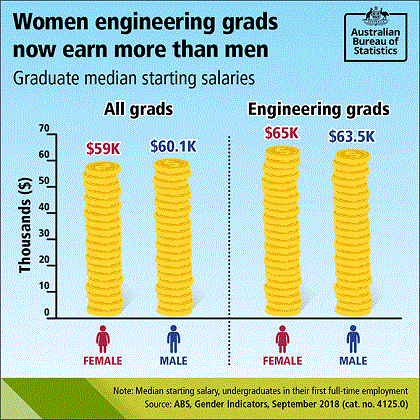
According to the ABS, female graduates still earn less than male graduates in 15 out of the 19 key industries but are on a par in the communications field.
These figures come from the Australian Graduate Outcomes Survey 2017, which was conducted by the Quality Indicators for Learning and Teaching (QILT) and released in February this year. They aim to provide students with relevant and transparent information about Australian higher education institutions from the perspective of recent students and graduates. The report is an aggregation of the experiences of recent graduates from 97 higher education institutions across the country.
The report also suggests the gender pay gap is closing. In 2016, the median full-time salary for female graduates was $3600 less than it was for male graduates across all study areas. In 2017, the difference in median wages fell to $1100.
HR director at engineers AECOM Helen Fraser told the Australian Financial Review back in February that the figures weren’t surprising.
"There is a shortage of technical talent for engineers. We are all fighting for the same group of people," Ms Fraser said.
Currently, women account for less than 20 per cent of engineering graduates. With companies now having to report on gender-balance, they need to try harder to attract women.
“It’s not the requirement to report, it's the desire to attract the talent. Because there is a shortage. There are more grads who have had multiple job offers - they have a choice,” said Ms Fraser.
The national president of Engineers Australia Trish White told Yahoo Finance that this is a reflection of the growing need for female graduates in the industry.
“The problem-solving of modern engineering is very human-centric, and so employers are looking to diversify their workforce, keen to recruit creative and communications skills as well as the technical,” she said.
“The difficulty is that only 13 per cent of working engineers in Australia are women, and the more experienced they are, the harder they are to find. So much so that we know of engineering companies that pay their staff ‘finders fees’ to bring in experienced women engineers for recruitment.
“It’s a great time for females to contemplate a career in engineering.”
While this is good news for new graduates, a joint report from the Bankwest Curtin Economics Centre and the Workplace Gender Equality Agency in 2016 demonstrated that the wage gap widens as time goes on, often because women take on family roles.
ABS Program Manager Dean Bowley said that young women are continuing to achieve higher levels of education than young men. The latest figures showed 45 per cent of women had completed a bachelor’s degree or higher before the age of 30, compared with 32 per cent of men.
“Despite this progress, there are still plenty of challenges,” he said.
“The gender pay gap has remained stable over the last decade, with women earning 89 per cent of the earnings of men, taking into account the differences in working hours. Superannuation balances for women approaching retirement are 37 per cent lower than men.”
The situation becomes more concerning at a postgraduate coursework level, where the median salary for female engineers is $15,000 less than it is for males. This was an increase from 2016 when the gap was $14,300. At a postgraduate research level, males typically out-earned females by $3000 in 2016 and $4500 in 2017.
According to Ms White, one of the reasons for this is the poor retention of women in engineering and a lack of female role models.
“Unfortunately women engineers are leaving the profession at greater rates than their male counterparts … It does mean there is a lack of female role models at higher levels. It’s hard to imagine yourself in a senior role if there isn’t anyone there that looks like you. I think that plays into promotion and pay rise negotiations as well,” she said.
“It’s not all a bad story, though, because some talented women engineers are being enticed by high salaries in banking and finance, which goes to show how transferable the skills of engineers are.”
India celebrates Engineering Day on the 15th of September every year. Google, this year, decided to honor one of India’s most celebrated engineers -Sir Mokshagundam Visvesvaraya. He was the Google Doodle for the day. Behind him on the Doodle, is the work he is most famous for; the Krishna Raja Sagara Lake and dam.
Popularly known as Sir MV, he was a lead player in the construction of the Krishna Raja Sagara dam in the North-West suburb of Mysore City. It was early in his career that it was clear he had an affinity for irrigation systems. Soon after his studies, he became the sanitary engineer for the government of Bombay.
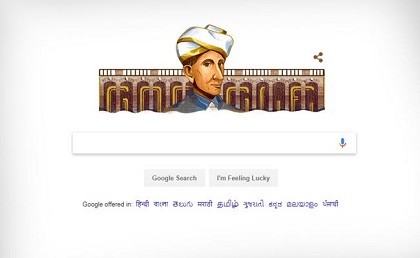
During his tenure in Bombay, he implemented a block system of irrigation that would provide irrigation for a large number of villages.
His mantra was: “Work is Worship”. When he looked at naturally occuring waterfalls, he knew that hydroelectric power could be harvested. He clearly had a knack for engineering. The government required his help - they needed to control some of their bodies of water in a better fashion.
A history of works
In 1909, he was enlisted to help prevent more floods in Hyderabad - which had just experienced a flood considered to be one of the worst in its history. It was thought that 15,000 people had lost their lives in the floods due to the Musi river being over capacity.
Flooding was not uncommon to the area, but the 1908 flood was particularly devastating. Some urban planning was thus necessary. Equipped with his knowledge of floodgates and reservoirs, Sir MV began work on remedying the situation .
Sir MV designed reservoirs that stored water that flowed over the Musi river’s capacity. He also built one across the Musi river tributary the Esi. Sir MV then went on to design a drainage system for Hyderabad that would prevent large scale flooding.
The region of Mysore then required Sir MV’s help. He became the Chief Engineer of Mysore State in 1909. He patented automatic weir floodgates at the beginning of the 1900s, and was determined to use them. He went on to implement these at Krishna Raja Sagara (KRS) in the biggest project of its kind at the time.

The main irrigation canal, an artificial tunnel that funnels water through it, was 2 miles long - an engineering feat India had never observed at that time in history. The Mysore area was suffering from an intensive drought before Sir MV had arrived. Agriculture was suffering immensely.
However, once the canal was implemented, sugar cane fields were able to be sustained which began a whole new sugar industry. As a result, civil engineering had immensely helped change the fate of a once barren, dry area.
He founded the Government Engineering College in Bengaluru in 1917. A college that was eventually named after him - embodying his craving for continuous societal improvement through technological advancement.
Sir MV was given the status of a Muslim council of state in 1912 in thanks for his contributions to civil engineering. He went to influence the rise of industry through the use of engineering technologies to create further prosperity. He authored books and pamphlets, detailing how the country should industrialize. He wrote an impressive list of books:
- Constructing India - Published 1920
- Rural Industrialization in India - Published 1931
- Unemployment in India: its causes and cure - Published 1932’
- Planned Economy for India - Published 1934
- Nation Building; a five year plan for the provinces - Published 1937
- District Development Scheme - Published 1939
- Prosperity Through Industry - Published 1942
- Village Industrialization - Published 1945
He dabbled in steelwork later in his career as well. He owned the Bhadravathi Steel Plant - creating steelworks that competed on a global market scale.
Even in his old age, he didn’t slow down. He drafted a document named the Rural Industrialization Scheme, asserting that the only way to inspire economic growth in rural areas was through industrialization. The Mysore government accepted the scheme and began its implementation. Soon, many states in India began implementing the scheme. He was also instrumental in suggesting where key infrastructure was to be placed.
In 1941 he founded the All India Manufacturers Organization. It’s motto was: ‘Prosperity Through Industry’. He was awarded the highest honor an Indian citizen can achieve: Bharat Ratna. He was named the Father of the Idea of Planned Development in the citation.
Sir MV showed that in a career of engineering, pausing work and being complacent is a waste of time. Even at an old age, an engineer can still be instrumental in inspiring societal improvement through engineering.
Works Cited
Bushan007. “Sir. Mokshagundam Visvesvaraya Documentary.” YouTube, YouTube, 19 Feb. 2014, www.youtube.com/watch?v=Uyhp7uu7o6c.
Hariharan, Revathi. “On Engineer's Day, Google Doodle Celebrates M Visvesvaraya's Birthday.” NDTV.com, 15 Sept. 2018, www.ndtv.com/india-news/engineers-day-2018-on-engineers-day-google-doodle-celebrates-m-visvesvarayas-birthday-1916818.
Germany has unveiled not one but two Hydrogen fuel trains. It is being celebrated as a world-first.
The train can traverse 600 miles (1,000km) of railway on a single tank of hydrogen. What is significant about this number is that it matches what diesel trains can do. The new-fangled trains can reach a speed of 140km/h (86.99 miles per hour).
The fuel cells are positioned on top of the train. The cells combine hydrogen and oxygen, then transfer them to lithium-ion batteries inside the train. The train then emits steam and water. Another 58 zero-emissions trains are to be sold to Germany.
The train has been specifically designed to operate on non-electrified railway lines. To refuel the train, there will be a hydrogen refueling station Bremervorde where a 40-foot-high steel container will be pumped into the trains. The train is also quieter than its diesel-powered brethren.
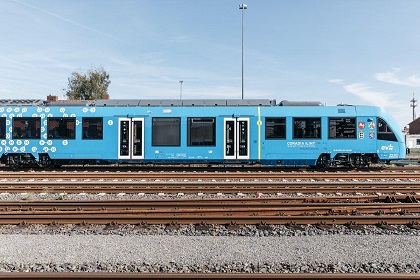
It is named the Coradia iLint, and is engineered by French sustainable mobility company Alstom. The train releases no emissions. It will take people from A to B on a 62 mile (100km) route between the towns and cities of Cuxhaven, Bremervörde, and Buxtehude.
Henri Poupart-Lafarge, chairman and CEO of Alstrom said:
“This is a revolution for Alstom and for the future of mobility. The world’s first hydrogen fuel cell train is entering passenger service and is ready for serial production. The Coradia iLint heralds a new era in emission-free rail transport. It is an innovation that results from French-German teamwork and exemplifies successful cross-border cooperation.”
The only question is: Will it be cheaper? A hydrogen train is more expensive to manufacture than a diesel train. However, Alstom says that the hydrogen trains will be cheaper to run and maintain in the long term - the same cannot be said for diesel trains.
Enak Ferlemann, Federal Government Commissioner for Rail Transport and Parliamentary State Secretary of the Federal Ministry of Transport and Digital Infrastructure said:
“Hydrogen is a real, low-emission and efficient alternative to diesel. These trains can be operated cleanly and in an environmentally friendly way, especially on secondary lines where overhead lines are uneconomical or not available yet.”
Works Cited
“World's First Emissions-Free Hydrogen Fuel Train Launches in Germany.” Interesting Engineering, 18 Sept. 2018, interestingengineering.com/worlds-first-emissions-free-hydrogen-fuel-train-launches-in-germany.
In a digital world, higher education becomes a shapeshifter.
Even after graduation, continuous and life-long re-skilling and up-skilling is becoming a necessity. The difficulty for universities is to keep up with the demand for new forms of education and training as a result of the internet age. Brick-and-mortar institutions are facing digital expansion and are struggling to stay ahead.
And for the current workforce, advances in this world of digital transformation simply threaten their jobs. A skills shortage has arisen and will continue to deepen if workers cannot access new and relevant skills.
Big data, business automation, and intelligence solutions are now becoming commonplace in the vocabulary of a modern workplace. Digital literacy is critical and according to the Australian Industry Group’s 2018 Workforce Development Needs Survey, Australian companies are struggling to find aptly trained individuals.
Australia’s workforce
According to the survey, companies are beginning to take on more apprentices and those fresh out of school. 48.1 percent of employers in the manufacturing sector are employing apprentices and trainees rather than qualified university students. They concede that they cannot find adequately skilled graduates for the positions they need to fill.

The companies themselves are endeavoring to train their own staff. And for their more formal qualifications, they encourage them to study externally, but part time, alongside their full time work.
To this end employers are familiarizing their workers with new digital technologies and putting managers in place to facilitate the training.
According to the report, technicians and trades workers are the most in-demand skilled labor in the country, but are also named as the least prepared for the oncoming digital transformation of the workplace.
Graduates getting less pay?
School leavers will be opting to do shorter vocational courses as the future of work alters. So says the Grattan Institute, who published a report about an impending decline of university graduate pay premiums.
In the past it was a non-issue; if a graduate made it out of university, his/her job and pay prospects were much higher when compared with a technical and vocational practitioner. But now, professional jobs in a number of industries are drying up and the ‘graduate premium pay’ is dwindling, according to the report.
Higher Education Program Director at the Grattan Institute, Andrew Norton, referred to statistics that pointed to the fact that 41.9 percent of 19 year olds in Australia were in university. He said:
“This feeds the argument that too many people are going to uni. People are taking very high risks in going to uni. My concern is there is a cultural juggernaut pushing young people into higher education when a more dispassionate analysis tells us it is not necessarily such a good idea. I think a logical extension is reviewing vocational education and training. Some people may choose the VET alternative over higher ed and that’s a good thing. A young guy with an ATAR of 60 would have earned more with a diploma than a graduate degree.”
The report shows that a woman with a bachelor degree in 2006 could expect to earn AU$15,000 more than a school leaver. And now - the report states the premium went to less than AU$13,000 in just a matter of years.
Universities Australia Chief Executive, Catriona Jackson, disputes the statistics and insists university graduates are still seeing an earning premium. She told Perth Now:
“While there has been a slight decline in the size of that advantage over a decade, that advantage is still pretty significant.”
What the report does not factor in, however, are alternative education and training options that ensure students can immediately offset the debt they accrue at university. Innovative online education institutions offer degrees alongside full time work and they also provide ongoing professional development.
Works Cited
Hiatt, Bethany. “Uni Degrees 'Aren't Paying off' with Jobs.” PerthNow, PerthNow, 16 Sept. 2018, www.perthnow.com.au/news/education/uni-degrees-losing-worth-in-jobs-market-find-grattan-institute-report-ng-b88962367z.
“Home.” Australian Industry Group, www.aigroup.com.au/.
How do you make a nanodevice move? Add some light. No, really.
A nanomotor is a molecular or nanoscale device capable of converting energy into movement. The motors are so small they can fit inside human cells. The benefits of engineering these kinds of motors in the future of biomedicine and robotics might be unfathomable.
The University of Texas at Austin is abuzz with the news that their mechanical engineers have — once again — achieved a breakthrough for nanotechnology.
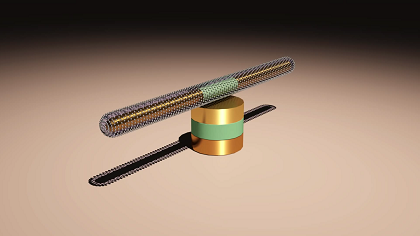
They have created a method for selecting and switching mechanical motions of nanomotors among multiple modes with visible light as the stimulus. The engineers are confident their findings can factor into the next generation of controllable nanoelectromechanical and nanorobotic devices.
The engineers liken light as a stimulus to a knob that can select the different modes of mechanical motions. The devices convert energy into movement at the cellular and molecular levels. The engineers utilized a laser for their testing.
The findings were published in the journal ‘Science Advances’ with the title: ‘Visible light-gated reconfigurable rotary actuation of electrical nanomotors’ Utilizing light the engineers succeeded in acceleration rotations of nanomotors, stopping rotation of nanomotors, and the reversal of rotation of nanomotors.
Donglei Fan, associate professor at the Cockrell School of Engineering’s Department of Mechanical Engineering and lead author on the project told UT News:
“The ability to alter the behavior of nanodevices in this way - from passive to active - opens the door to the design of autonomous and intelligent machines at nanoscale. We successfully tested our hypothesis based on the newly discovered effect through a practical application. We were able to distinguish semiconductor and metal nanomaterials just by observing their different mechanical motions in response to light with a conventional microscope. This distinction was made in a noncontact and nondestructive manner compared to the prevailing destructive contact-based electric measurements.”
This was not the first time the team made giant strides forward with nanomotors. In 2014, the team designed the smallest and fastest nanomotors. Their latest experiment included utilizing the light sources, an electric field and semiconductor nanoparticles in a water-based solution.
Works Cited
“First-Ever Method for Controlling Nanomotors Is Developed by UT Engineers.” UT News | The University of Texas at Austin, 18 Sept. 2018, news.utexas.edu/2018/09/18/ut-engineers-develop-first-method-for-controlling-nanomotors.
A recently formed civil engineering company, the Boring Company, is planning to further tunneling and tunnel mechanics. The CEO happens to be the hotly debated Elon Musk.
He has been inspired by the challenges of the Los Angeles transport infrastructure and believes that with California famously splayed across the San Andreas Fault, tunnels would survive an earthquake.
However, a journal published by Springer points out that for tunnels to be completely safe from earthquakes, they have to be as deeply embedded in the ground as possible. An excerpt reads:
“Experience shows that underground structures, especially deep ones, are far less vulnerable to earthquakes than superficial ones. The earthquake waves can also be amplified within soft superficial strata. In addition, loose water-saturated soil may lose its strength (so-called liquefaction), and this can lead to landslides or failure of foundations and retaining walls.”
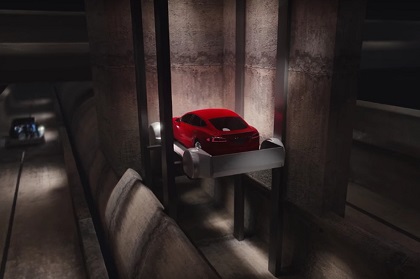
So going deeper is better. And aside from the already established underground subway system, the big question is what else we could be routed underground?
Elon Musk is determined that Los Angeles’ traffic congestion would be solved with tunnels. Talking on Joe Rogan’s podcast, the Joe Rogan Experience, Musk says:
“I’ve lived in LA for sixteen years and the traffic has always been terrible. I don’t see any other ideas for improving the situation. So, we are going to build a tunnel. And, maybe it will be successful but maybe it won’t.”
The probability of success has not stopped Musk from testing how useful his underground tunnels might be. The Boring Company recently suggested that they could make access to iconic venues much more accessible than they already are. People who are going to stadiums to watch sport or their favorite musician perform are usually in a bit of traffic outside of the venue.
The Boring Company published a proposed tunnel construction from Los Feliz, East Hollywood to Dodger Stadium in the City of Los Angeles.
Musk reiterated on the podcast that the tunnels are earthquake-proof, whereas above-ground roads can experience a high level of damage during an earthquake.
“Tunnels are very safe in earthquakes. Earthquakes are essentially a surface phenomenon. It’s like waves on the ocean. So, if there’s a storm, you want to be in a submarine. The way a tunnel is constructed - it’s constructed out of these interlocking segments, kind of like a snake. It’s sort of like a snake exoskeleton with double seals.
Trelleborg Infrastructure has uploaded a video, on YouTube, of how robust of an immersed tunnel can be. It is created with Gina gaskets and Omega seals. In the video, an earthquake is simulated displaying how pliable an immersed tunnel is. It also shows that the tunnel retains its structural integrity:
This corroborates what Musk was saying, when he told Rogan:
“And so, even when the ground moves, the tunnel is actually able to shift along with the ground - like an underground snake. And, it doesn’t crack or break, and it’s extremely unlikely that both seals would be broken. And, it’s capable of taking five atmospheres of pressure. It’s water-proof, methane-proof, or gas proof of any kind. It meets all California seismic requirements.”
Skepticism
Musk’s tunneling ideas have been met with some skepticism and with the need for an environmental impact analysis the project is likely to be delayed for quite some time.
Joshua Schank, the leader of Metro’s Office of Extraordinary Innovation talking to Curbed Los Angeles said:
“Technology doesn’t take precedence over the environmental process. You can have the fastest tunneling machines and the greatest mode of transport, but none of that affects the political or environmental process.”
Nonetheless, assuming Musk’s underground tunnels are given the green light, he may be missing the thumbs up from property owners across California. The associate director of UCLA Lewis Center and the Institute of Transportation Studies, talking to Curbed LA said:
“The best way to do this would be to negotiate with the state of California and build it under the freeway system. But those roads are built for 65mph, not more than 100, and you’re going to need to take wider turns. Inevitably it’ll go under private property and all it takes is one person’s refusal before you have to re-engineer everything.”
Musk may be banking on the fact that the science is there, together with the fact that the tunnels may just solve an oncoming congestion crisis.
Furthermore, Musk believes that transport systems should consider a three-dimensional approach. He said:
“If you can go 3D on your transport system, then you can solve all traffic. You can either go 3D up with a flying car, or 3D down with tunnels. You can have as many tunnel levels as you want. You can arbitrarily relieve any traffic.”
Musk concludes that if you go down deep enough you could create 100 tunnels, thus solving a congestion issue on the surface. Whether or not the Boring Company will be given clearance to go ahead and create what they are envisioning is a moot point, but the fact that engineers are dreaming about the future is positive.
Works Cited
“Earthquake Effects on Tunnels.” SpringerLink, Springer, link.springer.com/chapter/10.1007/3-540-28500-8_18.
“Joe Rogan Experience #1169 - Elon Musk.” YouTube, 7 Sept. 2018, youtu.be/ycPr5-27vSI.
Tinoco, Matt. “5 Reasons Why Experts Are so Skeptical of Elon Musk's Solution for LA Traffic.” Curbed LA, Curbed LA, 18 Dec. 2017, la.curbed.com/2017/12/18/16748436/elon-musk-tunnels-los-angeles-criticism-explained.
Could solar and wind farms create gardens of Eden in the desert?
According to a newly published study in the popular journal, Science, bringing rain to the desert with solar arrays and wind turbines is not far-fetched. The study is entitled: ‘Climate model shows large-scale wind and solar farms in the Sahara increase rain and vegetation’.
The researchers assert that as each solar and wind farm grows in size the ‘consequences’ for the climate increase too. With solar panels on the ground, the earth reflects less heat back into the atmosphere. And when turbines spin, warmer air is combined with cooler air. These occurrences can change the local climates.

Utilizing a climate prediction model, researchers suggest that rainfall would increase and with this more vegetation would grow.
This is not the first time scientists have asserted that big solar farms and wind farms could cause climate change. In 2012, the journal Nature put out a report that pointed to how wind turbines raise temperatures. The story looked at satellite imagery over Texas - a state with some of the world’s largest wind farms - and found that over a decade the temperature was raised by 0.72C (1.3F).
Speaking to the Telegraph in 2012, Liming Zhou, Research Associate Professor at the Department of Atmospheric and Environmental Sciences at the University of New York, said:
“Wind energy is among the world’s fastest growing sources of energy. The US wind industry has experienced a remarkably rapid expansion of capacity in recent years. While converting wind’s kinetic energy into electricity, wind turbines modify surface-atmosphere exchanges and transfer of energy, momentum, mass and moisture within the atmosphere. These changes, if spatially large enough, might have noticeable impacts on local to regional weather and climate.”
While climate change - and global warming - is mostly viewed as negative, bringing vegetation to the ever-creeping Sahara Desert may be more positive.
The latest study published in Science was completed by scientists at the University of Maryland. They considered climate and vegetation models and tested a theory that solar and wind farms could create a favourable climate in areas like the Sahara and Sahel. The theoretical result indicated that more rain would indeed fall in those areas.
Safa Motesharrei, UDM Systems Scientist and a lead author of the paper, told Engineering & Technology:
“The Sahara, the Sahel and the Middle East include some of the driest regions in the world while experiencing high growth of population and poverty. Our study has major implications for addressing the intertwined sustainability challenges of the ‘Energy-Water-Food’ nexus in this region.”

This study – with the promise of increased rain and vegetation - offers a solid counter-argument to those that suggest large-scale wind and solar farms adversely affect the climate.
The researchers at Maryland write:
“Our simulations show that both the wind and solar farms in the Sahara contribute to increased precipitation, especially in the Sahel region, through the positive albedo-precipitation-vegetation feedback.”
And the added benefit to solar and wind, in the long term, will be the replacement of fossil fuel technologies which currently power desalination plants. Motesharrei notes:
“Moreover, the availability of vast quantities of clean energy would allow for desalination of seawater and transporting it to the regions that suffer most from severe freshwater scarcity, in turn, leading to improvement of public health, expansion of agriculture and food production and even restoration of biodiversity.”
Works Cited
Gray, Louise. “Wind Farms Can Cause Climate Change, Finds New Study.” The Telegraph, Telegraph Media Group, 29 Apr. 2012, www.telegraph.co.uk/news/earth/earthnews/9234715/Wind-farms-can-cause-climate-change-finds-new-study.html.
Li, Yan, et al. “Climate Model Shows Large-Scale Wind and Solar Farms in the Sahara Increase Rain and Vegetation.” Science, American Association for the Advancement of Science, 7 Sept. 2018, science.sciencemag.org/content/361/6406/1019.
The convergence of machine learning and engineering is perhaps the most important crossing of paths in modern times.
Companies in a plethora of industries are expected to (and already are) opting-in to the AI future. As technology advances, it is up to the prospective engineer to adapt to the innovation that is occurring and use it to their advantage.
Machine learning and certain levels of AI have seen in the automated industrial warehouse. However, ‘AI’ and ‘machine learning’ have become a little like buzzwords in the engineering world today. Entry-level engineering students might be questioning what exactly might be impacting the future workplace they are studying towards. What does this so-called threatening AI look like?

CEO of machine learning company Iprova, Julian Nolan explains:
“For example, a smart microphone could have embedded algorithms that normalise input audio levels and clean out an adjustable level of background noise. If it does this in real-time to minimise the need for post-production, it doesn’t mean the microphone uses AI; it is using algorithms that can process data very quickly. It’s impressive, but it isn’t quite AI.”
Nolan even makes the distinction that the digital assistants from Amazon, Samsung and Google - that are seemingly artificially intelligent - lack the hallmarks of what a truly artificially intelligent system might look like.
He explains:
“But while we’re still many years away from truly using AI in many electronic products, AI is already beginning to transform the development of new electronics at the invention stage. Iprova, for example, uses advanced machine learning to converge myriads of data from seemingly unrelated industries to generate truly novel intentions for their clients.”
Electronics and AI
Bringing data generated in several different engineering industries together could lead to new technologies that could potentially change the world. Getting computers to correlate and compare data from seemingly unrelated industries and suggest new inventions out of it is when AI will genuinely be considered sentient. Alternatively, so alludes Nolan. He calls this ‘augmenting human intelligence’.
However, the embedding of a machine learning within electronics is becoming industry standard, at the moment. Every smartphone must act as a smart, almost human, personal assistant these days. The cameras inside electronics are getting much better, too.
Stanford University engineers have thrown their AI-prowess behind image recognition technology. They have developed an artificially intelligent camera that recognizes objects it ‘sees’ in the real world, much faster than previous camera systems before it. It is more energy efficient as well.

Gordon Wetzstein, an assistant professor of electrical engineering at Stanford, who led the research, alluded to the fact that this would help minimize the reasonably large, ‘energy intensive’ computer that runs inside of a self-driving car. The engineers at Stanford have experimented with fusing an optical computer, with a digital electronic computer to speed up the image recognition.
The engineers intend to continue engineering the computers so a camera can recognize its surroundings at (literally) the speed of light. Autonomous vehicles have to make the same split-second decisions that humans do when controlling a car. The engineers say that the marrying of the two computer types gives lessens the mathematical load required. The optical computer preprocesses the image data through a customized optics layer via light and subsequently does a lot of the precise number crunching.
The engineers at Stanford say this saves a lot of time and energy otherwise consumed by computation in single computer systems. The engineers plan to continue making the system smaller and smaller, and improving autonomous cars as they go along.
Works Cited
“How AI Is Helping Engineers Invent New Ideas.” Mechanical Engineering History Timeline - IMechE, www.imeche.org/news/news-article/how-ai-is-helping-engineers-invent-new-ideas.
Stanford University. “New AI Camera Could Revolutionize Autonomous Vehicles | Stanford News.” Stanford University, 22 Aug. 2018, news.stanford.edu/2018/08/17/new-ai-camera-revolutionize-autonomous-vehicles/.
Williams, Alun. “Comment: How AI and Convergence Turns Electronic Engineers into Invention Developers.” Electronics Weekly, 14 Aug. 2018, www.electronicsweekly.com/news/comment-ai-convergence-turns-electronic-engineers-invention-developers-2018-08/.
The advancement of technology has its advantages, especially for rural areas and low-income households around the world. With microsystems and nano-engineering, processes can be made more efficient and the cost of operation reduced.
Also, some engineers have turned their skills in this direction, designing complex wearable technologies that are improving, and in some cases saving people’s lives. Wearable technologies are revolutionizing industries as they focus on the health of workers usually at risk.
For example, miners, inside mines, can utilize wearable technologies to monitor their health and safety underground. Also, innovation is continuing.
Engineers at the University of British Columbia have invented an ultrasound transducer. A transducer is a device that converts a variation in a physical quantity, such as pressure or brightness, into an electrical signal or vice versa.
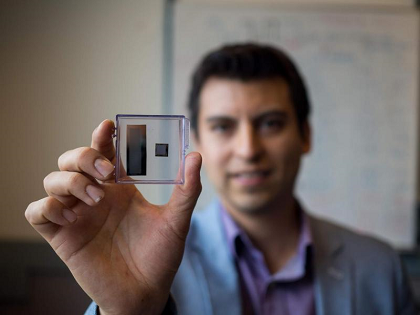
Essentially they have designed an ultrasound sensor that can be carried around in a pocket. So, how did they do it? It’s all up to the transducer. Instead of piezoelectric crystals, which allow us to see inside the body with traditional ultrasound scanners, they have used ‘small vibrating drums made from a polymer resin’.
Lead author on the study, Carlos Gerardo, a PhD candidate in electrical and computer engineering at UBC said:
“Transducer drums have typically been made out of rigid silicon materials that require costly, environment-controlled manufacturing processes, and this has hampered their use in ultrasound. By using polymer resin, we were able to produce polyCMUTs (polymer capacitive micromachined ultrasound) in fewer fabrication steps, using a minimum amount of equipment, resulting in significant cost savings.”
The technology only needs 10 volts to function, so a smartphone can thus power it. The resulting sonogram is purportedly a more precise, crisper sonogram than those using piezoelectric transducers.
Ultrasounds are not the only use for this technology. The researchers insist that they can look under the skin for arteries and veins and can scan heart activity through the chest. The technology should benefit many because of its ability to monitor a range of health issues at a fraction of the cost. The researchers believe, at market value, the tech will cost USD$100.
Works Cited
Gerardo, Carlos D., et al. “Fabrication and Testing of Polymer-Based Capacitive Micromachined Ultrasound Transducers for Medical Imaging.” Nature News, Nature Publishing Group, 27 Aug. 2018, www.nature.com/articles/s41378-018-0022-5.
“New Technology Yields Cheaper Ultrasound Machine.” Research & Development, 11 Sept. 2018, www.rdmag.com/article/2018/09/new-technology-yields-cheaper-ultrasound-machine.
Dear Colleagues
We talk about ongoing learning and development for people all the time but I believe many managers only pay lip service to genuine learning opportunities. Many times, an employee is on a training course to ‘tick the box’ to comply with some ‘magical’ company development plan.
We all need to make learning a key part of what we do in business. Not only does this provide useful technical skills but it helps to boost the firm’s culture in a positive way. There is no doubt in my mind that a huge amount of training is totally wasted with no tangible outcomes besides having a ‘jolly’ at the firm’s expense.
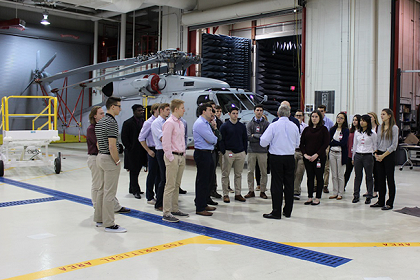
Humble Suggestions
A few suggestions on building learning as a key part of your activities:
You should always talk to your colleagues about how your learning is genuinely boosting your skills and expertise. You have finished a course on variable speed drives/pump cavitation problems/corrosion so that you can troubleshoot current problems or design with the latest concepts. Show everyone real benefits that you have achieved and motivate them to engage in a similar journey.
On the other hand, if you come back from a training course with the observation that it was ‘interesting’ it is likely that it was a total waste of money and time. You need to show real tangible benefits from the training or education. Something that will benefit not only you but the firm.
Don’t hide failures but learn from them. A great way of learning huge amounts is via analysis of current projects that may have failed or didn’t deliver the results everyone expected. Do a detailed assessment of what happened with the failed project and ensure everyone learns from it. A failure is often a key pathway to a successful outcome. Certainly, a great way of learning.
Make it easy to engage in learning or training courses. When someone goes on a training course make sure they are supported while they are away. Nothing is more disconcerting than having one’s phone ring for urgent help with troubleshooting of that pesky conveyer belt tramp iron magnet while you are on a course.
Training and development isn’t a comfortable experience. Ensure that people engaging in learning know that it may be a challenging and demanding experience. Learning about new technologies and approaches can be tough especially when you have to challenge and change old approaches in undertaking a project. This may cause some angst and uncertainty but this is all part of the learning process.
Freshen up your work experience. Another great way to learn huge amounts is to join new projects with unfamiliar challenges and where you are expected to draw on new expertise or perhaps move to to a new location.
Thanks to Kristi Hedges of Georgetown University/Harvard Business Review for some thoughtful commentary.
I like this old Chinese Proverb (from Alice Fonda-Marsland): A man who asks is a fool for five minutes. A man who never asks is a fool for life.
Yours in engineering learning
Steve
Mackay’s Musings – 19th September’18 #679
SA Power Networks is South Australia’s electricity distributor. And what a dynamic organisation it is too.
Steve Mackay, the Dean of the Engineering Institute of Technology, and a colleague were shown through the building at 1 Anzac Highway in Adelaide, on the morning of the 28th of August by Barney Nyirenda, the designated guide. He certainly knew his stuff and was clearly proud to be a part of this great company.
That afternoon Steve was invited back for a graduation; a number of SA Power employees had completed their advanced diplomas. Some were graduating from a TAFE qualification and some from EIT’s Advanced Diploma of Applied Electrical Engineering.
Steve was honoured to address the audience of students and support staff. He congratulated them earnestly – expressing his deep pride in their achievements. As an experienced engineer himself he also outlined a number of ways the graduates could boost their careers.
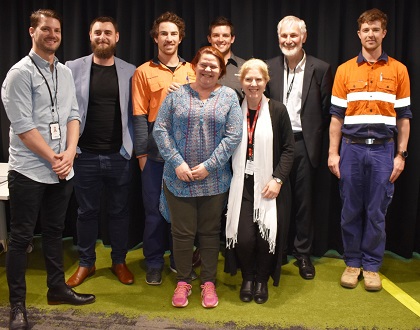
He urged them to remain positive; to be the problem solvers, not just the fault finders. But he did recommend that they do the necessary research before making decisions, and to always consider the worst-case scenarios.
He pointed out the importance of communication skills – suggesting that these softer skills were critical to the success of engineering professionals.
He spoke of the importance of fitting into an organisational culture – particularly one as positive as SA Power Networks. And urged the graduates to be innovative; building value into everything they do.
Business and entrepreneurial skills, he suggested, needed honing even when working for an employer. And linked with this, Steve advised them to keep their technical expertise sharp – with an eye on what the marketplace needed.
He counselled them to be friendly, positive and respectful, to all fellow workers - throughout the organisation. He explained that they would receive support of others in return.
He concluded by urging them to make learning – in all its guises – a life-long ambition and in everything, to follow their hearts (yes, an engineer said this).
For his final comment Steve drew on one of his heroes’ directives to never, never give in and never give up – a theme Sir Winston Churchill repeated throughout his life.
Civil engineering is in an era of transformation. Traditional methods of site surveying are changing and are becoming more informed by technologies.
Drone technology is assisting many different industries in the built environment to become more cognizant of studying the big picture. Drones can now monitor places from a heightened position, offering engineers further insight into the projects they are involved with.

The Independent featured Lamberto Frescobaldi in an article about drone technology. He is the head of a 700-year-old Tuscan vineyard, which is undergoing a new construction project. The site is being monitored from above by drone technology, to help engineers keep an eye on the whole construction process.
The drone data can help the engineers make decisions on-the-fly, more accurately than they would have without the technology. Drone technology can help engineers mitigate equipment failure. It can also assist in general surveillance of the construction site, which is a huge plus for engineers.
New research published by Frost & Sullivan indicates that the implementation of drone technology at construction sites around the world is not slowing down. This research is entitled ‘Global Digital Transformation on the Building and Construction Sector, Forecast to 2025’.
The authors warn that a failure to adopt digital transformation will result in inefficient construction projects. Companies that don't adapt may be surpassed by those who are implementing these newer technologies into their projects. An excerpt from the report reads:
“Despite the increasing availability of digital solutions, the industry has to overcome the challenge of rolling out technology across multiple sites, subsectors, and stakeholders. The way forward will be a platform that promotes interoperability. The regulatory framework has to be strengthened as well and the overall perception of industry stakeholders has to be debunked to enhance awareness and the willingness to invest in this digital transformation journey.”
Another overlooked benefit of the drone technology is the safety of on-site personnel. For example, when skyscrapers are being constructed, fewer workers would need to be hoisted up for external surveying. Instead, inspectors could examine the drone footage.
For the higher-ups of engineering companies, the benefits are even clearer. Mike Winn, the chief executive of drone company DroneDeploy, told the Independent:
“The head office can see what’s going on, and the safety team, the costing team, the designers - all of them can contribute to the project, share data and comment on it, without actually going to the job.”
Consequently, construction companies and engineers who do not familiarize themselves with the digital transformation occurring in the industry risk not being able to level up when the majority of companies transform. The uses of drone technology in the construction sector are growing every year — making construction sites more efficient, safer, interconnected, and far removed from what they were in the past.
Works Cited
Madigan, Nick. “How Drones Are Revolutionising Construction and Real Estate.” The Independent, Independent Digital News and Media, 1 Sept. 2018, www.independent.co.uk/life-style/design/drones-revolutionising-construction-real-estate-how-architecture-a8512021.html.
ltd, Research and Markets. “Global Digital Transformation on the Building and Construction Sector, Forecast to 2025.” Research and Markets - Market Research Reports - Welcome, www.researchandmarkets.com/research/htcjm2/global_digital?w=5.
Blog - Steve Mackay
EIT's Technical Director, Steve Mackay, enjoys keeping his blog up-to-date with useful tips and current industry matters for his fellow colleagues. He has a loyal and expanding following base reaching over 300,000 people around the world.
Student Stories
In this section you have the opportunity to read and listen to EIT students talking about the reality of the programs. Discussions are wide-ranging and include information about the study commitment required, the value of the qualification in their careers, the relevance of the subject matter, future pathways, and more. They provide valuable feedback for you to take into account before you decide to join one of our programs.
Career Information
Latest career information including industry research, podcasts, blogs, life hacks and general information about how you can make the most out of your career.
Education
Here you will find out more about the latest trends and developments within education worldwide, along with some helpful articles regarding study tips and keeping on track with your studies.
Developments
The latest innovation and inventions from the world of engineering can be found here. Learn about advances in technology and how they can make a real difference within your industry.
Announcements
Keep up to date with the latest announcements from the Engineering Institute of Technology. In this section you can read more about new courses, new recognition from professional bodies, our Excellence in Teaching Award, upcoming free webinars and much more.
Monthly Update
We understand that you may not have time to read all the articles that we post, so our monthly update gives you access to some fascinating articles which cover the best of the months news in a compact format.
